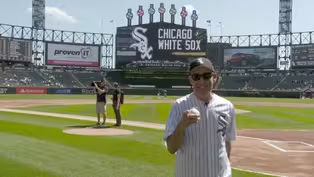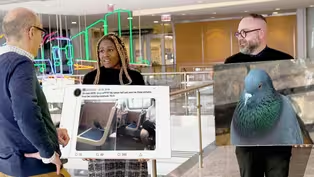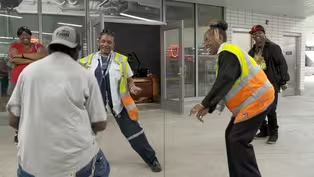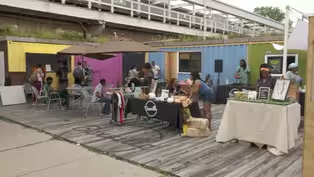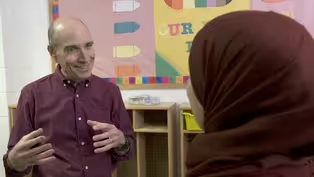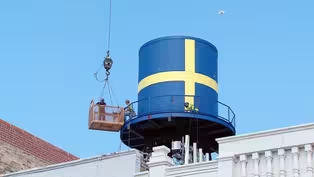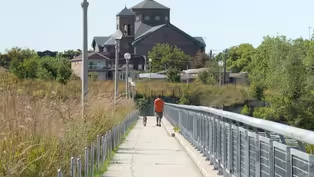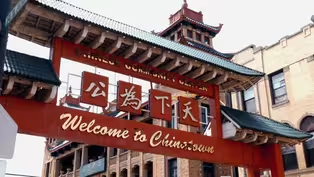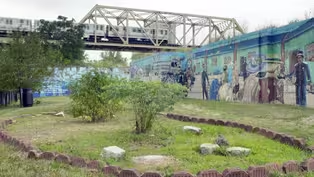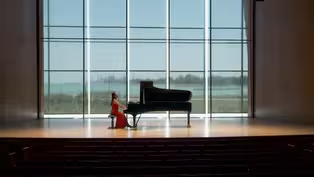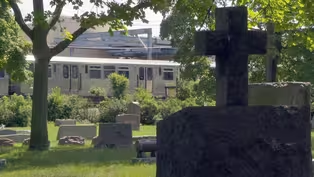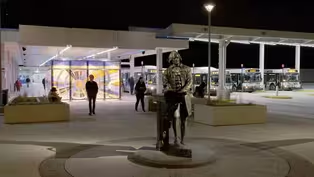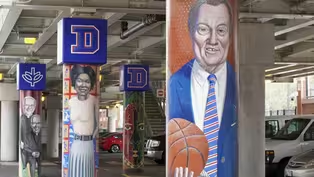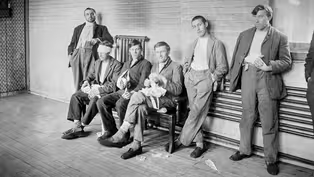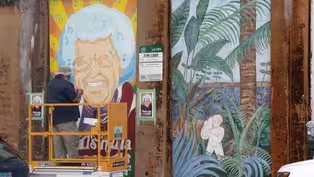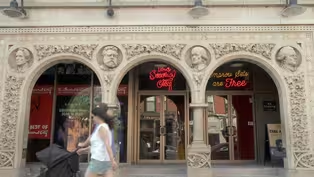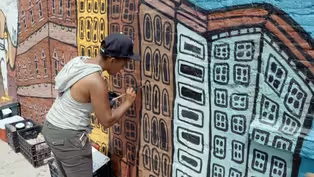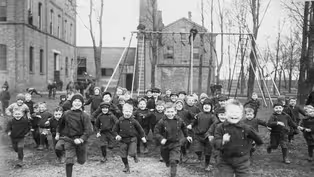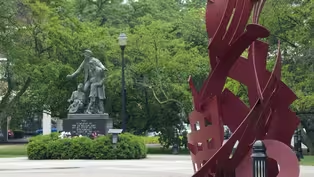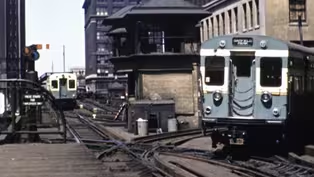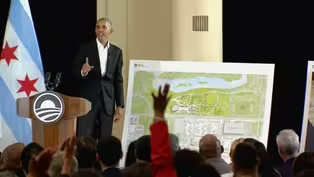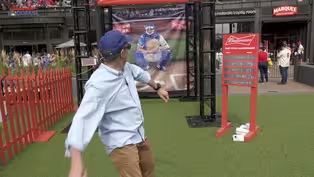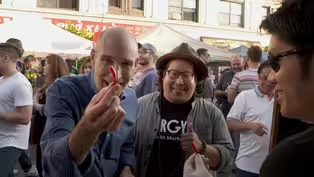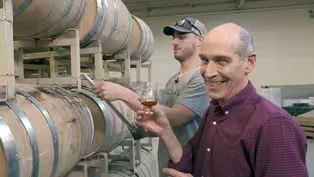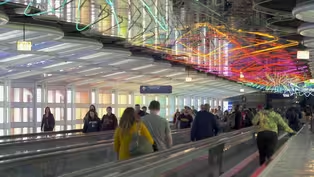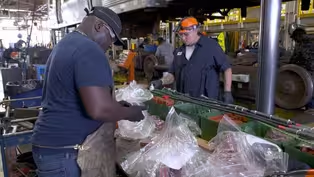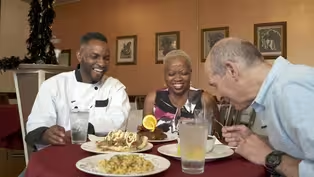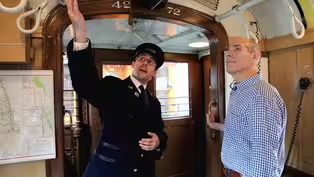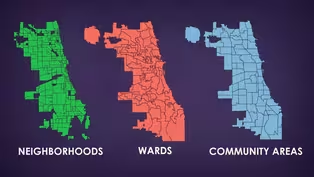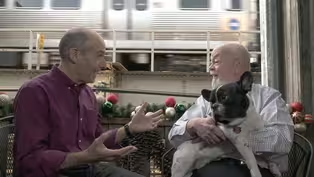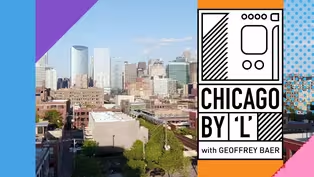
Chicago by 'L' with Geoffrey Baer
Special | 2h 10m 29sVideo has Closed Captions
Take a fascinating tour of Chicago neighborhoods along the elevated train system, the 'L'.
Geoffrey Baer hops on the CTA's famous Red, Blue, Green, Brown, Orange, Yellow, Pink, and Purple Lines to bring you a fascinating exploration of the colorful and diverse neighborhoods that Chicagoans access via the city's storied elevated train system.
Problems playing video? | Closed Captioning Feedback
Problems playing video? | Closed Captioning Feedback
Chicago Tours with Geoffrey Baer is a local public television program presented by WTTW

Chicago by 'L' with Geoffrey Baer
Special | 2h 10m 29sVideo has Closed Captions
Geoffrey Baer hops on the CTA's famous Red, Blue, Green, Brown, Orange, Yellow, Pink, and Purple Lines to bring you a fascinating exploration of the colorful and diverse neighborhoods that Chicagoans access via the city's storied elevated train system.
Problems playing video? | Closed Captioning Feedback
How to Watch Chicago Tours with Geoffrey Baer
Chicago Tours with Geoffrey Baer is available to stream on pbs.org and the free PBS App, available on iPhone, Apple TV, Android TV, Android smartphones, Amazon Fire TV, Amazon Fire Tablet, Roku, Samsung Smart TV, and Vizio.
- [Geoffrey] If - there's one thing That instantly says Chicago, it's the L. (train passing) Our downtown is named for it, and it sprawls out - beyond the horizon, - connecting neighborhoods, Rich and poor, trendy and traditional.
I'm Geoffrey Baer, and I freely confess, I love the L. It's the best way for me to show you Chicago, (food sizzling) Its many cultures.
- What do you think about it Geoffrey?
- It's hot, It is hot!
Hidden gems.
- At first, did you think - how can we do all this, - In this, like, - shipping container?
- We're really big on utilizing what we have, and resources, and making it happen.
- [Geoffrey] And - world-famous treasures... - Oh yeah!
- [Geoffrey] And the L is a story in itself, from the schemers who built it, to the unseen controllers who keep it running.
And the one voice that every Chicagoan knows.
(L-train doorbell rings) - Doors closing - (laughing) - [Geoffrey] The only things more colorful than a CTA map are the neighborhoods and people we'll meet on along the tracks.
Next stop, Chicago, by L. Leadership support for "Chicago by L with Geoffrey Baer" is provided by BMO Harris Bank with major funding by Peoples Gas, proud supporter of arts and culture in Chicago.
Joyce and Matt Walsh.
And Patty and Dan Walsh in memory of Richard Gray and in honor of Mary L. Gray.
Additional support is provided by Ann and Rich Carr, The Joseph and Bessie Feinberg Foundation, ITW.
And Jim and Kay Mabie.
And by the following donors: - If this restored, prairie-style station house could talk, oh the memories it would share.
(soft upbeat music) Of old-fashioned L trains, of commuters in wool suits and fedora hats, and families dressed up for a Saturday of shopping in the Loop.
A new station replaced it in 1993, here in Wilmette, at the farthest northern end of the L system.
Today, we call it the Purple Line.
The station might be newer, - but for the first - leg of our journey, We'll ride on a vintage L train.
These were part of the 6,000 series of L cars, that served from 1960 to 1992.
Yeah, I know, they used to be painted green.
Like me, many people consider these the quintessential L cars.
Oh man, this is great.
I totally remember these trains.
- I used to ride - them all the time.
Yes, I'm old.
Like all our L lines, this one began as a private company.
- In this case, the Northwestern - Elevated Railroad, Which ran from the Loop north to Wilson Avenue and was extended all the way to Wilmette by 1909.
(bell ringing) Long ago, virtually all the land in this affluent town belonged to one couple, Archange Ouilemette and her husband, Antoine.
She was Potawatomi, - and he was one of - Chicago's first settlers.
The U.S. government gave them more than 1,000 acres of lakefront land in exchange for helping negotiate treaties that banished Native peoples west of the Mississippi.
But just a few years later, the Ouilemette's moved west to join them.
Their children later sold all that land for $1,000 dollars.
- Well there was no - air-conditioning On these trains, but who needs it?
Remember this, you just roll up the window.
(soft upbeat music) Heading south we cross the North Shore Channel.
This man-made river was built - as part of a - mind-boggling project To reverse the flow of the Chicago River, so that our sewage would no longer flow into Lake Michigan, - ya know, the source - of our drinking water.
The channel originates at a lovely lakefront harbor in Wilmette.
Gates control the flow of water into the river system, and soaring above the harbor is Wilmette's most famous landmark, the Baha'i House of Worship.
(soft piano music) The Baha'i faith was introduced to America at the Chicago World's Fair of 1893.
The founder of the faith was a Persian prophet named Baha'u'llah.
He preached the oneness of the world's religions.
Symbols of many world religions can be found in the lavish ornament.
Construction started in 1920 and took more than 30 years to complete.
The canal weaves through Wilmette and into Evanston.
- The strip of government land - on either side is leased To a golf course with some very unusual obstacles.
(club smacks) Purple is not only the color of Evanston's L line, it's also the color of its university, Northwestern.
Probably not a coincidence.
- Universities like - Northwestern seem to be In a perpetual race to outdo each other with dazzling new buildings, like the Global Hub - for the renowned Kellogg - school of Management By a Canadian architecture firm KPMB, and the Bienen School of Music designed by Chicago's Goettsch Partners.
When it opened in 2014, Chicago Tribune music critic, John von Rhein, raved about both the architecture and the acoustics.
(plays piano) (clapping) Northwestern gave birth to Evanston in 1853, - when the fledgling - school purchased the land And mapped out the town.
Evanston is in fact named for one of the university's founders, John Evans, a personal friend of Abraham Lincoln's.
Those founders were devout Methodists, and they not only declared Evanston dry, they forbade the sale of alcohol within four miles of campus.
Saloons that flouted the law became frequent targets of temperance crusaders.
The most influential temperance crusader of all lived in this historic house in Evanston.
Frances Willard was president - of the Women's Christian - Temperance Union.
Under her leadership, the WCTU became - the largest women's - organization in the country - And championed broader - social reforms, Including women's suffrage.
By the time she died in 1898, she was said to be the most famous woman in the world.
Evanston long ago lifted its ban on booze, and it's now home to microbreweries and a craft distillery.
But progressivism remains deeply embedded in the DNA of this community where some live in stately lakefront homes and others struggle in poverty.
- The city council and - schools have adopted Formal policies promoting racial equity and immigrant protection and to fight climate change.
Evanston kids don't have to run away to join the circus.
(soft music) One of America's foremost schools of circus arts is right in town, the Actors' Gymnasium founded in 1995.
The terminal at Howard Street (bell rings) - is where we say goodbye - to the Purple Line... - [Intercom] Doors closing.
- And hello to maybe the oddest L line of all, because it's very short and only has two stops.
(soft upbeat music) - What's the curious history - of the Yellow Line?
Well, it runs on tracks laid in the 1920s for high-speed rail service all the way to Milwaukee.
This was the Skokie Valley branch of the North Shore Line, one of many interurban train lines - that connected - cities in the days Before improved highways put them all out of business.
The North Shore Line's sleek Electroliners shared L tracks from the Loop to Howard Street, - chomping at the bit - until they could go Full throttle, 90 miles an hour, on their own Skokie Valley tracks.
When service to Milwaukee ended in 1963, the CTA took over a short segment - between Howard and - Dempster Street To create a shuttle billed as the Skokie Swift.
(club smacks) The view of these power lines from the train is definitely less than scenic, but it's a big clue to this line's history.
- Commonwealth Edison - president, Samuel Insull, Built this railroad in part to develop the sparsely populated farm towns in the Skokie Valley into modern suburbs that would of course need electricity from ComEd.
- Before the North Shore - Line came through here, Skokie was just a small hamlet of mostly German immigrant farmers called Niles Center.
It was so remote that Baby Face Nelson's henchmen dumped his body here in 1934, after a fatal gun battle with the FBI in Barrington.
Skokie is a Potawatomi word sometimes translated as swamp, which is exactly what surrounded Niles Center until the land was drained in the 1930s.
Jews began migrating to the re-named community in the 1950s, from traditional enclaves in Chicago.
At one time they made up more than half the population of Skokie.
Today, the community has become a melting pot.
A quarter of the population is now Asian American.
And nearly 100 languages are spoken in Skokie homes, according to surveys taken by the local school district.
- The Chicago Tribune - called Skokie The Ellis Island of the North Shore.
The Yellow line dead-ends at Dempster Street.
The old prairie-style Dempster station built in 1925 for the North Shore Line was moved 130 feet to the east and beautifully restored for re-use as retail.
Instead of trains, it now serves cars and coffee.
(helicopter propellers whirring) Now, let's board a modern-day L train at Howard Street, and head south on the Red Line.
(soft upbeat music) - The density of houses - and apartment buildings Along the tracks tells us right away - we are not in the - suburbs anymore.
- You know, as a - sheltered suburban kid, - The only time I ever - got to ride the L - Was when we'd go - to the Cubs games, - And I would ride - on this very line.
I couldn't believe how close we came to all the buildings.
- I don't know which - was more exciting, Riding the train or seeing the Cubs.
Probably riding the train.
Rogers Park is one of Chicago's most diverse neighborhoods.
And its affordability has long attracted artists.
The cobblestone Glenwood Avenue Arts District is home to Chicago-style storefront theaters, live music venues, art studios, and galleries.
Rogers Park was once a suburb of Chicago.
Like many neighborhoods, it was annexed to the city in the late 1800s.
The neighborhood shared the national spotlight in 2018, when Loyola University's basketball team scored upset after upset, making it all the way to the NCAA Final Four.
- Cheering them on - from the sidelines, - Blessing them in - the locker room, And offering post-game analysis was 98-year-old team chaplain Sister Jean, who became a national media darling in her own right.
Loyola is one of the largest Jesuit universities in the country.
It was founded in 1870, the year before the Chicago Fire, at what is now St. Ignatius College Prep on Roosevelt Road and moved to this lakefront campus in Rogers Park in 1909.
Loyola's beautiful art-deco style chapel is called Madonna della Strada, which roughly translates to Our Lady of the Highway.
Why?
Well, when the chapel was built, - there were plans to - extend Lakeshore Drive To Chicago's northern boarder.
- But the highway - never came through, So Our Lady of the Highway looks out to sea instead.
Continuing south, we cross into Edgewater, another former suburb that's now a Chicago neighborhood.
The Andersonville enclave in Edgewater claims to have Chicago's largest LGBTQ+ population.
Historically lesbian, the gay population has diversified in recent years.
The neighborhood is also famous for fiercely promoting local businesses.
The Swedish American Museum, - which was always a - winner with my kids When they were this age, recalls an earlier population that settled in the neighborhood.
The Swedish flag water tower atop the building has been a neighborhood beacon for nearly a hundred years.
So important, in fact, that when the original wooden tower had to be removed in 2014, it was replaced with a non-functional replica.
(train rattles) Next stop's Argyle, and the station itself gives you - a big clue to the - ethnic identity Of a part of this neighborhood.
(soft upbeat music) (people chattering) This is where a weekly night market gives you a taste of pan-Asian street food.
- [Geoffrey] Okay, - wait a second, hold on.
- One of these!
- How hot is that?
- That is pretty - hot, one of them.
- Really?
- Yeah.
- If I bit that, it - would be all over.
- It might burn.
- I would cry?
I would cry if I bit that?
All right, one chili.
I'm a one chili guy.
My guide is Hac Tran from a merchants association that promotes this strip as Asia on Argyle.
- [Vendor] It's not that hot.
- "It's not that hot," he says.
- [Vendor] It's refreshing, - a good combination Of the sweetest and spicy.
- What do you think - about it, Geoffrey?
- It's hot!
It is hot!
(food sizzling) So, what are you cooking?
(speaking foreign language) - So she's grilling up - skewers, beef skewers, - Chicken skewers, - as well as squid.
- I'm not gonna be polite, - I'm just going to bite it.
- What do you think - of the marinade?
- Oh my god, it's - like a marinade?
- Yeah, it's probably fish sauce, sugar.
- I don't want to reveal - all her secrets.
(speaking foreign language) - She's not gonna to tell us?
- She's not gonna tell us.
- Oh okay.
(laughs) - [Hac] It's her secret.
- [Geoffrey] Asians are among - many immigrants and migrants Who found a port of entry in Uptown in the mid-20th century, including Appalachians and Native Americans.
The idea of a new Chinatown along Argyle dates back to the 1960s when a few Chinese restaurants opened here.
But the person most often credited with making it happen was relentless promoter Charlie Soo.
He was known as The Mayor of Argyle Street.
His small grassroots group got city grants to remediate the rundown street and storefronts in the 1980s - and attracted shop - owners, restaurateurs, And new immigrants, like Hac Tran's parents.
- My dad taught English, my - mother was his assistant, And they met there.
- In 1975, they fled - the Vietnam War, And actually a few years later, they reconnected on this street.
- On Argyle?
- On Argyle.
- And they both reconnected - there over a bowl of pho.
- If it weren't for pho and this street, you would not be here - talking to me today.
- That's correct.
- How do you feel when - you see a crowd like this?
- Because of my - connection to this area, I feel loved in a way.
That people are coming here, supporting the businesses, and just having a great time for themselves.
- That trickles down to - the community members, And we see that support.
- I mean, I have seen more than - a few people come up to you And like, shake your hand.
- Maybe I'll be - the new mayor.
- New mayor, yeah!
Uptown was known for a nightlife long before the Night Market.
(jazz music) The Aragon Ballroom and Riviera Theater are reminders that this was once one of Chicago's so-called bright lights shopping and entertainment districts.
Many were clustered around L stations.
(swing music) The big department stores, they're gone, - but you don't have to - use your imagination To remember the history.
Just pop in to The Green Mill jazz club, which is still swinging almost every night.
♪ From dusk till dawn ♪ ♪ And so at last I travel on to Avalon ♪ - Uptown's opulent Wilson L station has been restored to its appearance in the neighborhood's glory days.
This was the end of the line for L riders coming from downtown Chicago, on the Northwestern Elevated, which is now the Red Line.
Later, the line was extend north to Howard Street and beyond along the right-of-way of a steam railroad.
(soft upbeat music) - What if you could - gather a who's who Of Chicago history all in one place.
Well, that's a good description of Graceland Cemetery.
(soft guitar music) It's the final resting place of Marshall Field, inventor of the modern department store, real estate magnate, Potter Palmer, and his wife, Bertha, the queen of Chicago society.
Industrialist George Pullman is buried under tons of steel and concrete to prevent desecration by labor activists.
There's haunting statuary, like Eternal Silence by Lorado Taft.
Architect Daniel Burnham who made no little plans has his own private island.
- Mies van der Rohe, - on the other hand, Favored a less-is-more statement.
Graceland was part of the rural cemetery movement of the 1800s.
It was the solution to overcrowding in urban cemeteries.
They featured bucolic landscapes with native plants, peaceful ponds, and rolling hills.
They were so beautiful - that they became - popular with picnickers.
- Just when you think you've - seen everything in Chicago, You discover another hidden neighborhood.
- Ever heard of Alta - Vista Terrace?
Each side of this block-long street is a mirror image of the other, modeled on London row houses, an oddity in Chicago.
But not as odd as the rather pompous developer who built it, Samuel Eberly Gross.
He also developed the suburb of Brookfield which he originally called Grossdale until fed-up residents renamed it.
(bell dings) (soft upbeat music) - Wee!
- The L and Wrigley Field go together like Chicago hot dogs and, well, everything except ketchup.
Charles Weeghman built the park for his Federal League Chicago Whales in 1914 to take advantage of the nearby L station.
Weeghman brought the Cubs here in 1916.
- He was the first - owner to allow fans To keep the foul balls they caught.
Weeghman sold the team to the Wrigley family in 1920.
A different family owns the Cubs today, and to say the Ricketts have transformed the whole neighborhood would be an understatement.
A former patch of gravel has been turned into a park open to the neighborhood except on game days when it's limited to ticket holders.
70 miles per hour, I get a hat.
No problem!
53!
That's not bad.
- [Man] Was that a change-up?
- Well, see, he's showing me - two fingers is a curve ball.
I got to throw a curve here.
The Hotel Zachary across Clark Street replaces a beloved McDonald's.
It's named for the architect who designed the ballpark, Zachary Taylor Davis.
Baez, okay!
- As the neighborhood - grew around the park, - Apartment dwellers - across the outfield walls Discovered their rooftops offered a fringe benefit.
Entrepreneurs eventually turned the rooftops into private clubs, setting off legal battles over the neighbors' right to profit from their views and the Cubs' right to block those views as they modernized the park with video scoreboards.
The Cubs finally put an end to the controversy by just buying up all the rooftops.
(bat smacks) Oh yeah!
- [Commentator] It's - going to be close.
Harrison Bader.
(cheering) (soft music) - Passing through some - neighborhoods we'll visit later, We enter the first subterranean stretch of the tour.
- In New York, they call - their transit system The subway even when it's elevated.
- Here in Chicago, - we call it the L Even when it's underground.
We snake our way beneath the Near North Side and below Rush Street bars packed with tourists, suburbanites, and bachelorette parties.
Just past Grand Avenue, we dip slightly downward, pass beneath the Chicago River, and arrive at the longest subway platform in the world, according to the Guinness Book of World Records.
(soft upbeat music) The State Street subway beneath the Loop is one continuous platform, and the train stops at three places along it.
Money to build it came from the WPA, part of the Roosevelt Era New Deal.
- After five years - of construction, Powerful Mayor Edward Kelly gave himself the honor of cutting the ribbon in October 1943.
We emerge from underground in the middle of a vacant parcel of old railroad land south of the Loop and pass Chinatown's pride and joy, Ping Tom Park.
It's one of my favorite places in Chicago.
This lovely Asian-themed landscape brought desperately-needed open space to Chinatown, and it pioneered the transformation of the Chicago River.
(steam hisses) (banging) Chinatown looks, feels, and definitely tastes like China.
Chicago's Chinese began migrating here in the early 20th century from an earlier Chinatown in the Loop.
They built this exuberant community center in 1928.
For all its convincing Chinese design, the architects were Norwegian-Americans - because there were - no Chinese architects In Chicago back then.
- When you think of - public housing, Stylish is not the first word that comes to mind.
But architect Bertrand Goldberg brought the same groovy aesthetic to Hilliard Homes that he created for Chicago's iconic Marina City.
- The Chicago Housing Authority - has beautifully restored Hilliard as a mixed-income development.
(soft music) It wasn't so long ago that the Dan Ryan was lined with mile after mile of high-rise public housing.
- Generations of - Chicagoans grew up And formed communities here.
Stateway Gardens and Robert Taylor Homes, named, ironically, for an African American activist who opposed high-rise public housing, were built in the 1950s and '60s.
- African Americans - had been concentrated In this area for generations by racist housing restrictions - and were later walled off - by the Dan Ryan Expressway, Which was supposedly re-routed here, to avoid bulldozing Mayor Richard J. Daley's power base just to the west in Bridgeport.
Without adequate support services, the towers spiraled into decay.
They were torn down beginning in 1997, - with a promise to provide - replacement housing.
After more than two decades, some affordable housing has been built, but much of the land still sits vacant awaiting redevelopment.
An oasis in the projects was this park, created on the site of an old coal yard in the 1980s.
It's named for Olympian Ralph Metcalfe, who shared gold in the relays with Jesse Owens in the 1936 Berlin Olympics and went on to become a Chicago alderman and U.S.
Congressman.
Alright, I hope my fellow Cub's fans don't see this.
(laughs) - Good afternoon, - ladies and gentlemen, And young White Sox fans.
- Welcome to Guaranteed - Rate Field, The home of your Chicago White Sox.
- [Geoffrey] Yes, the Red Line serves both of Chicago's major league baseball teams.
One of the White Sox all-stars doesn't play baseball.
He's the most famous groundskeeper in America, Roger Bossard, AKA, the Sodfather.
- Are you ready?
- I'm ready, man.
- Alright, let's take a walk.
- Bossard has helped - teams around the country Create their fields of dreams.
And before each Sox game, he custom-grooms the infield to the preferences of each player.
- If there's a bad hop - today, I'm blaming you.
- [Geoffrey] It's my fault.
- Exactly, exactly.
- But no amount of TLC from Roger and his crew can help me now.
I am so nervous!
- With the mic and the cameras, - I'd imagine you're gonna go - from the top of the mound.
- Yeah, oh yeah.
- You got everybody watching.
- [Commentator] Please - give a warm welcome From WTTW, Geoffrey Baer.
(soft upbeat music) (laughs) - Well, at least I didn't - throw it in the dirt.
- [Aaron] It hit the - ground, so we're good.
- Hey, thanks a lot man.
- [Aaron] Absolutely.
- That was about - as high and inside As a high inside pitch could be, but at least I didn't throw it in the dirt.
In this age of screens, the live action at the ballpark has a lot of competition for your attention.
- Action one, ready one.
Take camera one.
- But Guaranteed Rate Field does have one low-tech reminder of dearly departed Comiskey Park.
(cheering) (popping) America's first exploding scoreboard - was just one of the - crowd-pleasing gimmicks Master showman Bill Veeck instituted after he bought the White Sox in 1959.
In the 1940s and '50s, the White Sox actually shared the ballpark with one of the great teams of the Negro leagues, the Chicago American Giants.
Their owner-manager and pitcher, Rube Foster, was also the president and treasurer of the league.
- All that pressure - eventually got to him.
He had a nervous breakdown in 1926 and retired.
You know, hosing down the field before the game was an honor.
But by the fourth inning, I'm ready for the showers.
Hey guys, I volunteered for this duty.
(laughs) Traffic at a standstill on the Ryan.
Should have taken the train!
(soft upbeat music) - 75th Street is a - good place to stop If you're hungry for barbecue, baked goods, or a vegan restaurant that could convert the most committed carnivore!
But that looks like ribs.
- It is ribs, I want you to know that.
It's just a form of vegan ribs.
- [Geoffrey] I got to try it.
- Please.
- Are you allowed to - say what it's made with, Or is that like a family secret?
- So, you see how it ripped?
It ripped really good.
(laughs) - So this is our - answer to ribs, though.
- That is unbelievable!
- And the great thing about our vegan food - is that you don't - miss the taste.
- Oh my god.
Brother and sister Arel Israel and Lori Seay now run this restaurant called Original Soul Vegetarian, founded by their parents in 1982.
Arel actually has never eaten meat or dairy in his life!
- How come we have Italian beef?
- [Lori] It's Italian - V, it's not beef.
- I love sandwiches.
I'm such a sandwich kind of guy.
- This is Chef Arel's creation.
- That's amazing!
- The thing about everything - that you're eating here, - It's made in house.
- Can't stop, huh?
- That's all made here, it's all sliced here, it's all baked here, and it's made for you.
- [Geoffrey] Vegan soul food might sound like an oxymoron.
After all, traditional soul food, born of slavery, was made from whatever scraps were available, including less desirable parts of the pig and fat used for frying.
Vegan soul food offers a healthy alternative while preserving the culture.
- Soul food is food that's good for the nourishment of the body.
You enjoy the taste.
It makes you feel warm and fuzzy inside once you eat it - Food brings a community together.
- Food is conversation.
- When you conversating - with somebody, It gives you an opportunity to get to know them.
- Understand them.
- And for them to - express themselves.
- Chatham is one of several - South Side neighborhoods Along the Red Line that changed from nearly 100% European American to nearly 100% African American - when restrictive - housing covenants Were outlawed in the 1960s.
Over the last half-century, - generations of - middle-class black families Have called it home.
Across the Dan Ryan is a surprising urban Eden in the neighborhood of Auburn Gresham.
Once a swampy lake, a developer drained the land - by building these - lagoons crossed By scenic bridges in the 1890s.
The neighborhood has suffered from disinvestment and population loss, making this little piece of paradise especially important.
Alright, we're pulling into 95th street.
It's like a palace for public transit.
(soft upbeat music) This $280 million train and bus terminal opened in 2019, - with state-of-the-art - interactive video signage And other customer amenities, and oh yeah, the occasional dance party!
(upbeat dance music) This DJ booth is called AESOP, which stands for An Extended Song of Our People.
- Bring it on up, come on!
There you go.
- Music soothes - the average beast.
- How are you?
- What's going on?
You ready to dance, too?
- No, I'm not a dancer.
- I mean, even if they - don't dance with us, They might laugh with us, - but they better when they - leave out of the station.
- [Geoffrey] Artist and community activist, Theaster Gates, dreamed it up as part of the CTA's public art program that enlivens L stations throughout the system.
The CTA says more than 80 works of art, made possible by government grants and private donors, create a friendlier, more inviting atmosphere for riders, and offer a glimpse into the rich history and unique character of the surrounding neighborhoods.
Back at 95th Street... (cheering) The art reflects the CTA's fundamental mission.
- Oh!
- I'm moving my hips!
- Let's go!
- [Geoffrey] To move people.
- [Geoffrey] Just like your car, L trains need a tune-up from time to time.
And just like your car, there's a place for that.
(bells ringing) Welcome to the Skokie Shops.
- Our hope is to get about 25 years out of an L car.
This one here with the truck down is the 5,000 series.
It's been operating for over 5 years.
It's time for its quarter-life overhaul.
- Typically with an L - car some of the things That take the most beatings are the big couplers up there that link one car to another.
- You are gonna develop - flat spots on your wheels.
It's a giant wheel lay that recuts those wheels into perfect roundness.
All of the flexible cabling that brings the 600 volt current to the motors.
We are literally turning out a married pair, - which is two cars permanently - married together, everyday.
With the 5,000 series we have roughly about 730 rail cars, so yes, it's a large number.
(chuckles) We are always challenged to think outside the box, and that keeps us moving forward and helps us maintain that huge demand of moving this many people in the city.
- On the Near West Side, the L overlooks Union Park, which one weekend a year hosts alt-rock and hip-hop fans at the Pitchfork Music Festival.
- Union Park was named in the - years before the Civil War To promote the union of the United States.
- Chicago's wealthiest families lived in this area before the Great Fire.
The neighborhood was spared but residents watched in horror as their businesses burned just blocks away.
After the fire the wealthy moved away, white and black working class residents moved in, and Union Park became one of Chicago's only integrated public parks.
Many of those folks belonged to labor unions, - which built their - union halls nearby, Lending a new meaning to the name Union Park.
The Ashland L station opened in 1893 - when stations along - this line looked Like Victorian painted ladies!
It's one of Chicago's oldest L stations, and it serves Chicago's newest L line, the Pink Line, which opened in 2006.
This part travels along a reactivated L structure that had been unused by the public since the 1950s.
There's the United Center, home of the Blackhawks and tonight the Bulls.
I'm always amazed by the workers who morph arenas like this in a matter of hours from basketball courts to hockey rinks, and on other days to concert venues and more.
Of course before there was a United Center there was Chicago Stadium.
FDR was nominated for president there three times.
And fans cheered the Bulls first three-peat, Stan Mikita, Sinatra and Elvis.
I saw my first rock concert there, The Beach Boys and Chicago together in 1975.
- The stately - neo-classical exterior Of the old Cook County Hospital stands in contrast to the decades of raw human drama that took place inside.
The TV series "ER" set here captured it pretty well.
- From the beginning, the - hospital served patients With little or no ability to pay for care.
It was also considered one of the country's top teaching hospitals.
- It established the first medical - internship in the country - And the world's - first blood bank.
Stroger Hospital replaced the aging Cook County Hospital in 2002.
- After sitting - vacant for 17 years - And being threatened - with demolition, A meticulous restoration began in 2018 to convert it into a hotel.
Today the Pink Line serves multiple health care facilities in this area dubbed the Illinois Medical District, including the dramatic butterfly-shaped Rush Medical Center by Ralph Johnson of Perkins and Will, completed in 2012.
Crossing all these railroad tracks, we get into Pilsen.
This whole neighborhood is so vibrant and colorful.
The L station at 18th Street welcomes you Pilsen style.
Almost every square inch is covered in artwork painted by community members reflecting the Mexican American heritage of the neighborhood.
Pilsen is famous for its murals, - many in the great - Mexican tradition Of political agitation through paint, advocating for workers' and immigrants' rights.
The Damen Avenue station is a good place for a coffee break.
- Do you know how to - do that whole thing - Where you put like - a little pattern On the top of the coffee?
- My thing with latte - art, I have a thing with... - Latte art?
- Latte art.
Our line in the morning is moving all the way, all the time.
- I tell them, "Listen, we - don't have time for that."
We're gonna serve them a good cup of coffee and they're gonna be happy.
- Eleazar Delgado, who owns Pilsen's famous Jumping Bean Café, opened this miniature version that he calls 'L' Cafecito to give riders an alternative to the corporate coffee found at other L stations.
- You have to have - that flow going.
- Now you get people sometimes - being like a little rude, - Like, "My train's coming, - my train's coming."
- Well, they'll come in, "How - fast can you make a latte?"
Well, watch me.
(laughs) It's not gonna have art.
- If the name Pilsen doesn't sound Mexican that's because it actually comes from the Bohemian immigrants who settled here in the 1870s.
- Mexicans began moving - into the neighborhood In the 1950s and '60s.
- It was really a whole - different neighborhood Than what it is today.
- How is it different?
- This is a neighborhood - of immigrants, And it's always been a neighborhood of immigrants so it's always evolving.
- The neighborhood's - history can be traced Through St. Adelbert's church.
Built in 1912 in exuberant Eastern European style, it later offered services in Spanish.
The archdiocese closed the deteriorating structure in 2016 and preservationists began a campaign to save it.
- There's a parallel - universe in Pilsen.
It's also an artist's colony.
A developer began renting cheap live/work loft space to artists decades ago in East Pilsen, which has been re-branded the Chicago Arts District.
- Artists show their - work once a month At an open house called Second Fridays.
Artists are often the vanguard of neighborhood change.
- Today, amidst the - Mexican restaurants, There are trendy bars and the old Thalia Hall that served Czech immigrants - has been restored - as a music venue.
But so far Pilsen has resisted wholesale transformation.
- What do you say - to people who say, - "Oh, a café, that's - gentrifying the neighborhood?"
- Yeah, we got accused of that plenty of times, but we're an organization that gives back, - and we hire from - the neighborhood.
- People say about - gentrification is it changes - The character of - the neighborhood, But it sounds to me you really wanna preserve - the character - Yes.
- of the neighborhood?
- The first thing when - people visit the café, From outside, "Wow really, three bucks for this latte?"
Yeah, why is something wrong?
- "You know you could be - charging a lot more for that."
- Well, yeah, but I love - this neighborhood.
I love the people.
- I love what the - neighborhood represents.
It's that community feel.
- You feel a sense of - pride being part of it.
It's a place for everyone.
- [Geoffrey] Just - west of Pilsen, The L crosses an earlier way of getting around Chicago, - one of America's earliest - boulevard systems.
If the L was created for speed, the boulevards were for enjoying the journey.
An 8-mile-an-hour speed limit was strictly enforced on this system of leafy pleasure drives that circled the city in the 1860s, connecting parks on the south, west and north sides.
Like Douglas Park, one of three spectacular West Side parks laid out in the 1870s.
The parks and boulevards offered an escape from overcrowded neighborhoods.
And they still do.
A program called Girls in the Game uses Douglas Park to bring healthy movement and messages to young women.
- It feels pretty awesome to be part of a team - because if we're down then - we have another person To get us back up.
- Many of these girls come from Chicago's most marginalized communities, like the neighborhood right next door, North Lawndale.
Lawndale was named by a developer in the late 1800s - to promote the - subdivision's suburban feel And proximity to Douglas Park.
Later, as industries like the McCormick Reaper Works and Sears moved nearby, immigrant workers moved in and built more homes - like these nearly - identical houses In a part of North Lawndale called K-Town - because all the streets - start with the letter K, Like Karlov, Keeler and Kedvale.
- There's a whole generation - of Jewish Chicagoans Who remember Lawndale as the Great Vest Side!
In the early 20th century, - Jews started moving - into the neighborhood - From the crowded - Maxwell Street area On the city's Near West Side.
And by the '20s and '30s, North Lawndale was a vibrant center of Jewish life, home to many synagogues and Jewish organizations - and nearly half the - city's Jewish population By some estimates.
- This is another - neighborhood that went From virtually all-white to nearly all African American starting in the 1950s.
Today former synagogues are black churches, and the old Jewish People's Institute is a charter school.
But African Americans couldn't own the homes they lived in here because the federal government wouldn't insure their mortgages.
By the mid-1960s, much of North Lawndale was suffering from widespread disinvestment and poverty.
In 1966, Martin Luther King and his family moved - into a dilapidated apartment - in the neighborhood To focus national attention on racist housing policies.
(sirens blaring) Two years later, his assassination set off widespread rioting.
At least nine people died, and many homes and businesses were destroyed.
This tower stands as a beacon for Lawndale's future.
It was Chicago's first Sears Tower.
It was part of the company's vast Merchandise Building, long ago demolished.
After lying dormant for decades it was restored in 2016 by a philanthropic group that rents affordable space - to neighborhood - service organizations, Including Free Spirit Media, - a group that trains - underserved youth For careers in video production.
- This old Chicago firehouse - has been converted To a Community Arts Center dedicated to interrupting the cycle of violence among youth by giving them a way to their stories - and learn job skills - through visual art, - Audio and video production, - and even fashion, Culinary arts and dance.
Look at that old tower.
That's all that's left of a huge Western Electric factory in Cicero, called Hawthorne Works.
Western Electric was like Apple back in the day.
At its height in the 1920s it made almost every telephone in America.
Some 25,000 people worked here.
- Those workers and - their families suffered An enormous tragedy in 1915.
More than 800 were killed in a bizarre steamship accident in the Chicago River.
They had boarded the S.S. Eastland bound for a company picnic in Michigan when the ship suddenly rolled over on its side.
It was the deadliest disaster in Chicago history.
(crossing alarm beeps) Cicero was once much larger, encompassing parts of Chicago, Oak Park and Berwyn.
- Its factories attracted many - Eastern European immigrants In the early 20th Century.
Al Capone famously made Cicero his base of operations in the 1920s.
- [Reporter] Betty, any last - comments before you go in?
- And it had its share of - political corruption later In the 20th century.
Today this working class community is majority Latinx.
It's been said the population of west suburban Forest Park is more dead than alive.
About 15,000 people live here, but more than 800,000 are buried in its many cemeteries.
- And some of those - permanent residents Took their final journey here on the L!
- The precursor to - today's Blue Line Once offered chartered funeral train service.
- While other cemeteries - discriminated, Forest Park's welcomed minorities and those on the margins of society, like the dozens of circus performers buried in a mass grave in Woodlawn Cemetery.
They were killed in a horrific circus train wreck in Northwest Indiana in 1918.
- Since then, many other circus - performers have been buried In what's known as Showmen's Rest.
Five anarchists hanged for their alleged involvement in Chicago's Haymarket Riot are buried in Forest Home Cemetery.
Decades later the famous anarchist, free speech champion, - and pioneering - feminist, Emma Goldman, Was buried nearby according to her last wishes.
Today the area around Goldman's grave is called Radicals Row because so many other anarchists - and activists are - buried near her.
Jewish Waldheim was originally a cluster of small cemeteries serving immigrant Jews - from Chicago's Maxwell - Street district.
Getting here by road in the 1870s was a day-long ordeal.
So, like nearby Lutheran Concordia Cemetery, Waldheim had its own L station.
- Don't get me wrong - about Forest Park.
There's a lot of life here.
The main drag has a quaint small town feel.
The 16-inch Softball Hall of Fame celebrates a game that's very much alive, and pure Chicago.
Softball was invented in Chicago in 1887 - by Yale and Harvard - alumni gathered At the Farragut Boat Club.
One of them threw a boxing glove at a rival alum, who hit it with a broomstick.
A 16-inch ball obviously replaced the boxing glove.
- As the game spread - across the country, The ball got smaller and harder.
But true Chicagoans still favor that big, mushy clincher.
And life is sweet in Forest Park.
Ferrara Candy Company began in 1908 over on Taylor Street making candy coated almonds used in traditional Italian weddings and grew to produce legendary sweets like Lemonheads, Red Hots, and Boston Baked Beans.
This was the first rapid transit line in America to run down the middle of a highway median.
But the train was here long before the Eisenhower.
- Like the Pink Line, - this was once part Of the old Metropolitan West Side Elevated, a privately owned railroad that went into service in the 1890s.
The tracks were relocated temporarily - while the expressway - was being built, And then permanently re-routed to the median in 1958.
All right, if we keep our eyes peeled here, we might just be able to spot the top of one of three basilicas in Chicago.
See it?
See the spire?
- All right, now you can - go back to your iPhones.
The dazzling Our Lady of Sorrows in East Garfield Park, completed in 1902.
A basilica is a church designated by the pope for its historical, artistic or religious significance.
The Chicago Architecture Center says this renaissance revival church may be the grandest in Chicago.
The University of Illinois Chicago was founded to serve students who wanted a state college education without leaving home.
- It was built at the confluence - of three major highways And originally dubbed Circle Campus, - making it probably - the only college named For a highway interchange.
Mayor Richard J. Daley's choice of this location in 1961 set off a huge battle with Greektown and Little Italy.
Residents led by restaurant owner Florence Scala appealed to the U.S. Supreme Court to save their neighborhoods, to no avail.
The bulldozers rolled and about 8,000 people and more than 600 businesses were displaced.
Architect Walter Netsch designed a concrete campus with elevated walkways built around a central amphitheater.
It was supposed to evoke a Greek agora.
- But like much of - modernist urban planning, It felt austere and unwelcoming.
Worst of all it was walled off from the surrounding city like a fortress.
The university has spent decades undoing the original design to humanize it, - bring in natural light, and - connect it to the neighborhood.
Well, Little Italy might be littler than it once was, but it's still big if you've got an appetite!
(people chattering) - You guys wanna - stop and eat this?
- [Geoffrey] The old - school Italian fare Is a living reminder of the crowded immigrant neighborhood that residents fought so hard to save.
And here's another reminder.
Jane Addams established Hull-House in the heart of this community to serve Italians, Eastern European Jews, Greeks and more as they struggled to make a new life in America.
Addams was born into a wealthy family.
- She moved into Hull-House - along with other women of means - And offered the - immigrant poor everything - From language and - cooking classes, To daycare, public baths, recreation and the arts.
Jane Addams was the first woman awarded the Nobel Peace Prize.
As we approach the Loop, the Blue Line goes subterranean.
And like all subways, it's really noisy down here!
♪ One, two, three, four ♪ - [Geoffrey] But between trains, the tunnels echo with sweeter sounds.
♪ And I lost all of my money ♪ ♪ Got a bell for you ♪ ♪ As I was walking ♪ ♪ That ribbon of highway ♪ - They've got this audience - and they're listening - And all of a sudden - they're gone, right?
- [Guitarist] Then you get a new audience, every 5 minutes.
You don't get too many critics.
(laughs) (drums beating) - So I actually wound up homeless in 2016.
(drums beating) - Somebody who was also a street - performer on the north side - Was like, "You should - get your permit.
- "You could probably - make some money."
- So I got my permit - with whatever address I could use at the time.
I've been doing street performing going on three years now.
- You know a lot of - people come down here - And to them it be - about the money, - But to use its just - about reaching the people On a positive note.
♪ Give me this down home blues ♪ - Unlike the Red Line, which - passes beneath the Loop In one straight shot, the Blue Line follows a curving path below the skyscrapers.
We're right underneath the Goodman Theatre.
- Don't worry, we're not - disturbing the show.
- When they built - the theater in 2000 They actually soundproofed it using technology designed to earthquake-proof buildings!
Rounding another bend, the tunnel takes us below Wolf Point where the three branches of the Chicago River come together and then heads northwest under Milwaukee Avenue.
- By the time we're - back above ground, We're far from the Loop in Wicker Park.
- And once again, we're traveling - on an L structure built For the old Metropolitan West Side Elevated.
The historic Damen Avenue station from 1895 has been restored and feels just as it did to riders more than a century ago.
Except the passengers have a lot more tattoos and man buns.
And there's ample parking for bicycles.
This was the epicenter of the fourth-hippest hipster neighborhood in the country in 2012 according to Forbes and Nextdoor.com - A different crowd first - settled Wicker Park After the Great Fire of 1871.
These beautiful brick and stone mansions were built by wealthy Germans and Scandinavians who fled the charred center of the city and wanted homes made of fireproof material.
Many mansions were later cut up into multi-family homes - as working class - Polish immigrants moved Into the neighborhood.
So many immigrants in fact that it was considered part of the Polish Downtown or "Old Polonia along Milwaukee Avenue."
The ornate North Avenue Baths offered immigrants from Russia and Ukraine a steam room, a cold pool and bowls of borscht, like in the old country.
The Chicago Tribune wrote that politicians loved it because it's hard to wiretap someone sitting naked in a steam room, By 1959, the neighborhood was sufficiently down on its heels that novelist and poet Nelson Algren lived - on the third floor - of this building, Where he wrote lovingly about Chicago's underbelly and carried on a torrid affair with French writer and feminist Simone de Beauvoir.
- Nothing better illustrates - the transformation Of this neighborhood than this once abandoned freight railroad embankment reborn as a lovely linear park called the 606, designed by the celebrated Brooklyn-based landscape architect Michael Van Valkenbergh.
It runs about 3 miles through Wicker Park, Bucktown, and Humboldt Park.
It opened in 2015 after years of being used by local urban pioneers as an unauthorized nature trail.
- Here's one place - that's been here Through all the ups and downs over the decades.
- Greek immigrant - Peter George Poulos Started selling gargantuan homemade ice cream creations and candies here in 1921.
Is this all?
His son later renamed the joint Margie's Candies for his sweetheart.
- The third generation - still runs it.
You don't think I can finish it?
Just watch.
- The Beatles famously - stopped here After their concert at Comiskey Park in 1965.
A few years later, the Rolling Stones showed up and asked to sit in the same booth as the Fab Four.
Here's a place to work off that banana split, The Royal Palms.
- All right, arm relaxed, - down, down, down.
- Feet together, step - and push with the left.
Look at that.
- Ah!
- Oh!
Now, I'm gonna try and hide around you there.
- Oh!
- That's a smooth 21 - points right there.
- Not bad.
- Sheesh.
And to think, I thought shuffleboard was only for retirees on cruise ships!
This branch of the defunct Metropolitan West Side Elevated once ended in Logan Square at a huge elevated terminal.
That old terminal is long gone and the line now descends back underground.
It passes right below Logan Square's most visible landmark, It's the Centennial Monument dedicated on the hundredth birthday of Illinois in 1918.
A century later Logan Square may have eclipsed Wicker Park on the hipster index.
The restoration of the run down Logan Theater in 2012 signaled a rapid change - in an already - changing neighborhood.
The western part of Logan Square remains solidly working class and brings the Latinx population in the neighborhood overall to almost 50 percent.
This exuberant Blue Line subway entrance in Avondale from 2019 by Carol Ross Barney proclaims in no uncertain terms that this is the Blue Line!
When we return to ground level we find ourselves in the median of the Kennedy Expressway heading for O'Hare.
We passed the old Polish Downtown a few stops ago.
But if you want a taste of Polonia, - Jefferson Park is the - place to get off the train.
(shouting in foreign language) - [Polish Re-enactor] This is - the winged cavalry of Poland.
- This is how they - would go into battle?
- [Polish Re-Enactor] - Yeah, you would go Into battle just like this, yes.
- It's a little - intimidating, I have to say.
Why is this annual fest of food and Polish culture here?
And this beer is called (speaks in foreign language) - Because this is the home of Chicago's Polish cultural center, the Copernicus Center.
Once a movie palace by the famous architects Rapp and Rapp, it was converted in the 1980s and a tower was added modeled on the Royal Castle in Warsaw.
Okay, where is Chicago's oldest house?
- It's way out here - in Norwood Park.
When English immigrant Mark Noble built this home in 1833, this area was just open prairie miles from Chicago.
Today the metropolis sprawls far beyond Norwood Park to the suburb of Rosemont.
- One of the most interesting - things about Rosemont Is that 1/3 of its land area is taken up with a highway interchange, - but they make pretty - good use of the other 2/3 And their proximity to one of the world's busiest airports.
Fewer than 5,000 people live in Rosemont, but it attracts more than 50,000 people each day thanks to its many hotels, convention center, Allstate arena, outlet mall and restaurants.
The community describes itself as an entertainment suburb.
Architect John Portman's Hyatt Regency O'Hare in Rosemont dazzles hotel guests with a soaring atrium and glass elevators.
Portman first used this formula for a Hyatt Hotel in Atlanta - and repeated it in dramatic - buildings all over the country, Including Detroit's famous Renaissance Center.
Rosemont has been governed by the same family since it was incorporated in 1956.
Donald Stephens served as village president for more than 50 years, until his death in 2007, when his son took over.
When you ride the Blue Line, you see some folks who have a very, very long daily commute.
So, where are you guys heading?
- We're going to Miami tonight.
- Going to Miami?
- That's right, yeah.
- You probably have - the biggest commute Of anyone in Chicago.
- We'll be home in about 9 hours - Do you ever worry that - you're gonna miss your flight?
- I've never been late on the train before.
- The train has - not made you late?
- [Casey] Never once.
- I've actually never - been late either.
- Really?
- Yeah.
- Should we have flight - attendants on the L?
- Train attendants?
- Train attendants!
- I don't know.
- I don't know, Amtrak does.
- Yeah, you know serving, - well no they don't serve - anything on airplanes anymore.
Should you have like an oxygen mask that falls down?
- Don't need it, not - at this elevation.
- Yeah, you're on the ground.
- True enough!
The Blue Line ends at O'Hare Airport in a terminal designed by famous German-born Chicago architect Helmut Jahn.
It opened in 1984, - when an extension - of the Blue Line From Jefferson Park was completed.
Jahn was a pioneer in making modern architecture more dramatic with his use of colors and curving shapes.
You can also see this in his United Terminal from 1987, - which features a - subterranean passageway To a satellite terminal with a dramatic neon sculpture on the ceiling by artist Michael Hayden.
Quite a departure from the spare modernism of the airport's original design by C.F.
Murphy Associates when it was dedicated by President John F. Kennedy in 1963.
The airport was renamed for WWII fighter pilot Edward Butch O'Hare in 1949.
He fought a solo battle downing five enemy bombers in 1942 in what his Medal of Honor citation described as the most daring single action in combat aviation history.
Less than two years later he died in one of the first nighttime aircraft carrier missions.
Butch O'Hare's father took a different path in life.
He was in business with Al Capone.
He informed on the notorious gangster and was gunned down in a mob hit in 1939.
(airplane engine roars) With the dawn of the jet age, - the construction of - the Kennedy Expressway, And the long-planned extension of the L here, - O'Hare was destined to - become the hub of air travel For Chicago and the entire nation.
I'd love to be jetting off - to some exotic destination - right now, but I've Got a plane to catch - [Geoffrey] The Green Line station at 63rd and Cottage Grove in Woodlawn is at the end of Chicago's oldest L line.
And what do you know?
Chicago's oldest restaurant is right here too.
- You want some more coffee?
- Please - What should I order?
- Everything on this side.
- On this side?
- Okay, this is the - breakfast side.
What's your favorite thing?
- I just had an omelet, - it was delicious.
- And how long have - you been coming here?
- When it was across the street, we used to go.
- It was a treat when - she would take us Over there across the street.
- If they got their - homework, you know.
- If you got your homework done.
So you were a kid when you came here?
- We'd just talk over here and that was a treat.
- [Host] An Irish immigrant named John Daley - opened the first incarnation - of this restaurant Across the street in 1892.
- He came to America - for a construction job Building the L, but realized there was money to be made feeding his fellow iron workers instead.
- All right, how are you?
- Good - [Host] The - restaurant's new building - Is part of the - redevelopment of Woodlawn.
- It was built with - federal grant money By a group called Partners in Affordable Housing.
- How long have you worked here?
- 34 years.
- 34 years?
You were like nine when you started working here.
- Haha, not quite.
- Has it changed a lot?
- It changed a whole lot.
- [Host] If the L looks - sorta chopped off here At Cottage Grove, it is.
When the line opened in 1893, it continued east all the way to Jackson Park, just in time to carry legions of fair goers there for the dazzling World's Columbian Exposition, the so-called White City.
- It took more than a - year to build the fair - And many of the - construction workers Were regulars at Daley's.
- What does Daley's mean - to this neighborhood?
What is this place?
- Family, it was always a family restaurant.
- Everybody came in, - they were family - So this kinda more like the real neighborhood, right?
- Real neighborhood, this is it.
- [Host] Since we're at the - end of Chicago's first L line, We'll ride the CTA's oldest operating train.
Built in 1923, it's lovingly restored, maintained, and operated by volunteers.
- Look at you guys!
- Welcome aboard.
- Thank you.
- [Host] One of those - volunteers has a day job As a CTA general manager.
Graham Garfield is a walking encyclopedia of L history.
- Look at these people in the - station here, they're like.. Hey, how you doing?
(laughing) - Oh, that's always - a lot of fun to see The reaction on people's faces, to see the rubbernecking, the surprise looks, and then a big smile on their face.
- [Host] It looks old - fashioned to us today, But it was a big improvement over the city's first L trains which were pulled by small steam engines.
These cars operated for half a century.
The last one was retired in 1973.
- Listen to that rumble.
That's the old L train right there!
- [Host] This part - of the Green Line Began as the South Side Rapid Transit Company.
- So the very first L line, the South Side Elevated, was actually built next to alleys for most of its length.
It earned it the nickname, the Alley L. - They actually - called it the Alley L In the advertising, right?
- They did yeah, in the - advertising and even painted On the elevated structure in a few places.
- So why run it up the - alley instead of running it Over the street as we see today?
- So a 1872 law called the Cities and Villages Act would have required them to get the consent - of at least half the property - owners along the route.
- Which requires?
- Usually bribes.
Or some other sort of horse trading, literal or figurative.
- [Host] The - World's Fair brought A building boom to Woodlawn.
- In the early 20th - century, the western part - Of the neighborhood was - one of the few places In Chicago where middle class African Americans could live.
But even here, they weren't free of racism.
Lorraine Hansberry based her landmark play, A Raisin in the Sun, on her own family's ordeal - when they moved into - this neighborhood.
A White mob threw a brick through their window.
On the eastern side of Woodlawn, White business owners and the University of Chicago used restrictive covenants to prevent Blacks from moving there until these racists policies were finally outlawed in 1948.
As the neighborhood became overwhelmingly African American in the 1960s, The Woodlawn Organization formed.
It used radical and sometimes controversial organizing techniques to achieve what it called Black self determination.
- But the neighborhood - continued to suffer From disinvestment and population loss.
Recently, more people are moving back into the neighborhood and property values are rising.
- Thanks in part to the - announced location Of the Obama Presidential Center nearby.
At King Drive, we pass the childhood home of Michelle Obama, the low income housing development, Parkway Gardens.
It was built by and for African Americans in the 1960s, offering them a rare opportunity for cooperative ownership.
It stands on the site of an amusement park that opened in 1905 and where African Americans were unwelcome; it was called, ironically enough, White City, a reference to the nearby World's Fair.
- Another branch of the - South Side Elevated Opened in 1907 to serve Englewood.
There was no Dan Ryan Expressway back then.
- Oh my God, look at this.
- I hope you're not - afraid of heights.
You've got the Green Line going over rail lines, going over the Red Line, going over the Ryan.
We're way up.
- It is a wedding cake of transportation, for sure.
- [Host] The L helped transform Englewood from a neighborhood of Irish and German stockyard workers into the busiest shopping district outside of downtown Chicago, anchored by a huge Sears store.
- The neighborhood went - from virtually all White, To nearly 100% African American, starting in the 1950s - when housing - restrictions were lifted.
- Banks stopped investing - in the neighborhood, And businesses and homeowners suffered.
An ill-conceived plan to boost business turned 63rd and Halsted into a suburban style mall.
It proved disastrous and by 2017 the population of Englewood had declined almost 75%.
- A powerful force for good - through the hardships - In Englewood and so many - other neighborhoods, Has been the Black church, like Englewood's Antioch Missionary Baptist Church.
- And many organizations - have stepped up To bring new hope to Englewood.
Kennedy-King College opened a 40-acre campus at 63rd and Halsted in 2007.
One of its signature programs trains future chefs for restaurant careers.
And if those aspiring chefs need to pick up a few ingredients, there's now a Whole Foods a block away.
It's part of Englewood Square, that opened in 2016 with city assistance.
Since then, Starbucks and other retailers have leased up almost all the available store fronts.
The group I Grow Chicago says it takes a holistic approach to, quote, heal the hood.
Yoga is one of the many programs - they offer to - Englewood residents.
- They recruited - about 50 neighbors - To help transform - an abandoned home And three vacant lots into this Peace Campus for mentorship, restorative justice programs, arts, urban farming, and other offerings by community members themselves.
- Why do you love the train?
I do too; why do we love the train?
- You know, I think it holds an appeal in some ways it's universal.
It's big and it's a little noisy, and it just has sort of a character all of its own.
But I also love history and they're a window into what life was like in Chicago in decades past.
But that informs sort of how we got where we are.
- If you don't see yourself, - you're not in there.
- [Host] Well we've given this - old train quite a workout.
So to travel the rest of the Green Line, let's jump back to the Garfield Blvd Station and pick up a modern day train.
Renowned Chicago artist Nick Cave took CTA station art to a whole new level at Garfield, surrounding passengers in nature-inspired imagery, a nod to Washington Park just down the street.
An optical trick, makes images on the supporting pillars transform as you walk past.
We get off the train at the very next station.
There's something you just have to see.
(upbeat music) It's called Boxville.
- Why shipping containers?
- I mean, shipping - containers are cool.
So I feel like there's a movement - going around everywhere - in shipping containers - But Chicago is the last one - to get on board with it.
- Entrepreneurs needs - space where it's not - As expensive as - brick and mortar.
- So this is a starting - point for them.
- So if you can make - it at Boxville, - Then you know that - you can make it In a brick and mortar space.
- [Host] Kaaron Johnson - manages Boxville.
It's a venture of Urban Juncture, - a group that's - incubating entrepreneurs In what was once the Black metropolis, the epicenter of African American business in Chicago.
- So this is the Maker's Box and we do custom apparel, graphic design, decals, business cards.
- So one stop shop for - all your custom needs.
- So we service a lot of - creatives, entrepreneurs, - Businesses.
- In there?
- All in this... - All in the box.
Half is production, half is graphics.
- At first did you think, - how can we do all this In this shipping container?
- Oh no - Not really - We're really big on - utilizing what we have, Resources, and making it happen.
Thinking outside the box.
- Outside the box!
- Except in it.
(laughing) - [Host] Bronzeville's heyday - in the early 20th century - Grew out of the Great - Migration that brought - More than half a million - African Americans To Chicago from the South.
That difficult journey is symbolized in Bronzeville's monument to the Great Northern Migration by a figure clothed in worn shoe soles.
- One of the few areas - where African Americans Could find housing in Chicago was a narrow strip of the South Side, known as the Blackbelt.
- Because African - Americans weren't welcome To shop in The Loop, they built their own downtown here.
At night, Bronzeville was alive with clubs where folks dressed to the nines to see some of the biggest names in Blues and Jazz.
- It was said that - if you held a horn At the corner of 35th and State, it would play itself.
This monument of a Doughboy, honors the African American 8th Illinois Regiment.
Blacks eagerly signed up to serve the country that marginalized them.
In World War I, the fighting 8th sent more than 2000 men to France.
Bronzeville's decline is sort of the flip side of the story we've seen in other - South and West - side neighborhoods.
- When restrictive housing - was ruled illegal, African Americans began moving out - of this overcrowded - neighborhood.
- So it's called, - Build Bronzeville.
- Yes - Why does Bronzeville need building?
- So a lot of times when it was opened up - for us to go to other - areas, we left the area.
And so now, it's time for us to come back and rebuild because it has culture, history, all of that is embedded in Bronzeville.
So our goal is to get people back to Bronzeville.
- Stay in the community?
- Stay in the community - and recycle a dollar In the community.
- [Host] Urban Juncture hopes this Bronzeville landmark will be the jewel in their crown as they renew the neighborhood.
It's The Forum, built in 1897.
It hosted performances, social events, union meetings, and political gatherings.
Until it fell into disrepair in the 1970s.
And then sat vacant for nearly 30 years.
Facing city-ordered demolition in 2011, Urban Juncture bought and stabilized it, and they've developed a plan for revitalization.
The Green Line takes a mysterious zigzag at 40th Street.
- So going around the bend here.
This is actually the ghost of a long lost L line.
- [Host] Once upon a time, the Kenwood Branch ran from here almost all the way to the lakefront.
The line was abandoned in 1957, but the concrete embankment was never torn down.
Today the top of it is an urban forest, - and the sealed up station - entrances and walls Have become canvases for community mural artists.
- Well we've passed - a lot of colleges And universities along the L. - Some of them are famous - for their academic programs Or their sports teams.
This next one if famous for a lot less.
- [Host] Because at the Illinois - Institute of Technology, Less is more.
- That was the motto - of the legendary Minimalist modern architect Ludwig Mies Van Der Rohe who not only founded the renowned architecture program here, he designed the whole campus.
- He became one of the - the most influential Architects of the 20th century.
His designs stripped away the ornamentation, leaving only steel and glass.
Many people consider Crown Hall the purest expression of his work.
Architecture students from around the world make pilgrimages here to study it.
- Which is ironic because - the building demolished To make room for it, was called Mecca Flats.
It housed a vibrant African American community.
- Future poet laureate - Gwendolyn Brooks Got a job there in 1936 working as a secretary for a spiritual advisor who sold charms and potions by mail.
In recent years, other big name architects have pushed Illinois Tech beyond austere Meisian Modernism, like Chicago's Helmut Jahn.
And another Chicago architect, John Ronan, whose Kaplan Institute has second story skin make of pillow like cushions that inflate and deflate for energy efficiency.
Internationally acclaimed architect Rem Koolhaas made the L itself a part of his design for the McCormick Tribune Campus Center, opened in 2003.
Quinn Chapel AME Church is home to Chicago's oldest Black congregation, founded in 1844.
Many early congregants were formerly enslaved and the church became a stop on the Underground Railroad.
- Later, it hosted speakers - like Frederick Douglas, Booker T. Washington, Susan B. Anthony, W.E.B.
DuBois, and Martin Luther King.
- At the dawn of the - automobile age, South Michigan Avenue was Motor Row, home to some of America's first car dealerships.
They literally invented how to showcase cars in ornate buildings with huge windows and strong floors.
In those days, things like headlights and speedometers were options, sold by other suppliers on the strip.
- After the car - dealerships moved on, The buildings were converted to industry.
Today, many are being restored as the South Loop gentrifies.
Okay if you Google, Chicago's oldest house, the top results all point to this one.
Clarke House, built on the wild prairie in 1836.
But wait a minute, earlier we saw a house from 1833 in Norwood Park.
So what gives?
Well, that neighborhood wasn't part of Chicago until 60 years later, so you be the judge.
Editor's note, Chicago wasn't a city at all when Clarke House was built.
Clarke House has a bizarre history with the L. Starting in 1872 before the L was even built, when new owners moved the house about 20 blocks south.
- Flash forward to - a century later, The city of Chicago bought the historic home and on a cold December day in 1977, they tried to move it back to near its original site.
- The trouble was, that - since they moved the house To the South Side, the L had been built.
So to move it back, they had to get it up and over the L tracks.
- [Host] It almost - worked, until it was time To lower the house back down again.
The jacks froze and the house was stranded in mid air for weeks until the weather warmed up.
This fortress like mansion on Prairie Avenue by Boston architect H.H.
Richardson dates from the time when this was Chicago's first Gold Coast.
Farm machine maker John J. Glessner and his wife Frances built it in 1887 on what was called the Sunny Street of the Sifted Few.
By the early 1900s, a seedy vice district called The Levy, had taken hold just a few blocks to the west and Motor Row customers were whizzing by on test drives.
A mass exodus of millionaires decamped to the North Side.
- By the time I worked as a - Glessner House tour guide In the late 1980s, this area felt all but forgotten.
How times have changed.
- It'd be really hard to - think of another neighborhood In Chicago that's had more develop in the last 20 years than the South Loop.
- [Host] Today, the few surviving historic homes are surrounded by condo towers, loft developments, empty nesters, and millennials.
The South Loop is also an urban canvas for muralists.
Columbia College, which specializes in creative arts and media, dreamed up the Wabash Art Corridor and claims it's one of America's largest public art programs.
- Columbia has plenty - of wall space to offer Because it gobbled up property around its South Loop campus back before the area was hot.
Riding the L is the ultimate communal experience with people from all walks of life crammed together.
- But in this digital - age, it's more and more Something we do alone together.
Still, there's one voice we all recognize.
- [Station Announcer] - Transfer to Orange, Pink, - Purple and Brown Line - Trains at Adams and Wabash.
- [Host] He's the most - familiar person on the L That almost no one has ever seen.
- [Station Announcer] - This is Merchandise Mart.
- This is Merchandise Mart.
- [Host] Meet the man behind the voice, Lee Crooks.
- How old are these - announcements?
- We started doing these in 1998.
So trying to have my voice sound the same, I'm a little older now.
I' was 38 when I started and I'm 60 now.
And so trying to, doors closing, - it doesn't come quite - as naturally as it used.
- Why, what would - it sound like now?
- Door closing, you know, - it'd be a little bit lower.
- A little lower, - a little more epic.
- In a world where - doors are closing.
- In a world where doors are closing.
(laughing) - You said they gave - you some direction.
Like this is the kind of interpretation we want.
- They wanted friendly, faceless, and benign.
I'm not making that up.
- Thanks again for all - the reminders everyday, And for helping me wake up in the morning.
- [Host] I think - someone is recognizing Your voice right here.
- I hear him everyday.
- I'm sorry.
(laughing) - Don't you feel like you're - just a part of the city?
- People keep telling me that.
- Because I live in - Milwaukee I don't hear it On a day to day basis.
But it crosses my mind once in awhile, yeah a little bit.
- If the L is the iconic - element of Chicago, You're the iconic voice of the L. - It's one part of what I do as a voiceover, but it's clearly the visible part.
- And I'm proud of - what we've done.
- [Station Announcer] Welcome - aboard Red Line Run 921.
(train whirring and clicking) - [Geoffrey] In the West Loop, the Green Line crosses over the Kennedy Expressway, - right where it - obliterated the site - Of one of the most - controversial chapters In Chicago history, the riot in Haymarket Square.
It happened on May 4th, 1886 when someone threw a bomb as police tried to break up a peaceful labor rally.
Seven policemen and an unknown number of demonstrators were killed.
Even though the bomber has never been identified, seven anarchists were convicted of murder and four hanged.
This monument in the West Loop honors both the workers and the police.
(train whirring) Not so long ago, - this was Chicago's - bustling wholesale produce, Grocery, and meatpacking district.
Today's it's home to some of the city's top restaurants, - and corporate offices - and tech firms Fill old warehouses and new buildings.
The influx of well-paid young office workers has ignited a red-hot residential market here, too.
Google earned some Chicago cred in their new offices with a retired L car repurposed as a rooftop employee lounge.
Workers in another building get the genuine article right outside their office windows.
(train whirring) Here's the Green Line's greenest stop, Garfield Park Conservatory, which opened in 1906.
(people chattering) - [Kid] Hey, look at those - hanging from the sky.
- [Geoffrey] It's one of the world's largest greenhouses.
Pioneering landscape architect, Jens Jensen, designed it in the shape of a Midwestern haystack.
At a time when most greenhouses just displayed a bunch of potted plants, Jensen composed elaborate naturalistic scenes that looked like real outdoor landscapes.
- Welcome to the vanilla vine.
What's unique about this vine is it can only be pollinated by one bee, and that's the Mexican Bee.
- So this right here - is my favorite plant.
- This right here is called - the Sensitive Plant.
When you touch it like this, it closes up.
And here's also a... - [Geoffrey] These - teenage tour guides Come from the high school directly across the street in East Garfield Park.
- What's your favorite - part about working here?
- Giving tours, I - like giving tours.
- Yeah.
- Yeah.
- [Visitor] You're - very good at it.
- Yeah, thank you.
- [Geoffrey] They're part - of the Urban Roots program That offers career and academic support in a neighborhood - where many have lived - in poverty for decades.
(train whirring) The long-abandoned Guyon Hotel on Washington Street in West Garfield Park recalls a different era.
When it opened as a residential hotel in 1928, it offered private motor coach and maid service.
The hotel's French Canadian proprietor, Louis Guyon, was a prudish former dance instructor who called the popular jazzy steps of the day indecent.
Guyon and others built a thriving mini-downtown clustered around Madison and Crawford, now Pulaski.
My grandfather's family owned one of those shops.
It was a men's clothing store called Baer Brothers and Prodie.
(people chattering) No the Green Line does not go all the way to Philadelphia.
But that sure does look like Independence Hall out there.
- Despite what the - inscription says, It's a park district fieldhouse.
But Austin was once a suburb of gracious homes on tree-lined streets.
And it was the seat of Cicero Township government.
Chicago annexed Austin in 1899.
- This is one of my favorite - buildings in Chicago, The former Laramie State Bank from 1929.
Like many buildings in Austin, it's long been vacant.
- This is another neighborhood - where disinvestment And population loss came in the wake of white flight.
(saw whirring) (hammer banging) (tool whirring) So day one, what are you doing to this house?
- Gut rehab.
(tool whirring) - Taking it to the bones - of the foundation, To the property, to the wood, everything.
Starting completely over.
- Why not just tear it down?
- Well, we're trying to save the neighborhood.
- [Geoffrey] Rosie Dawson - is a property manager Working with a group called West Side Health Authority that hires people from the neighborhood to rebuild the neighborhood.
It's a program called 100 Men, 100 Homes.
- We were really hit hard here in Austin.
A lot of abandoned properties as a result of the foreclosures and people leaving Austin.
- We first went to - the banks and said, - What are you doing - with those properties?
- You need to do - something with them.
And the banks said, if you want 'em, take 'em.
(laughs) (tool whirring) - [Geoffrey] So they did.
- And they're not - only fixing them up, They're teaching job skills in a neighborhood with high unemployment.
- What's the big goal of your organization?
- Our big goal is to really figure out - how do we rebuild - our neighborhoods, And not let other people dictate - how our neighborhoods - should change.
But let us be the change agents within our own neighborhood.
- [Geoffrey] Have you - seen the impact of that On the community?
- Oh, yes, absolutely.
- I can image when - you first come in, You just kind of get a feeling?
- You get a feeling of you save - one house, you save a block.
- You save two houses, - you save a community.
(hammer banging) (nail gun clicking) - How much more work do - you still have to do?
- When we first started doing these projects, you couldn't give away a house in Austin.
Now we're seeing home values climb above $200,000.
We're selling those homes within months where in the past it took us over a year to sell a house.
So I think the work is getting to a point where we feel very satisfied.
(train whirring) - [Geoffrey] One of the realities - we've seen in neighborhoods On the Green Line is segregation.
But Oak Park, at the end of the line, is known for diversity.
In the 1960s and '70s, while Austin right next door was transitioning from virtually all white to nearly all black, Oak Park officials and clergy worked closely with residents to encourage integration throughout the community.
For Sale signs were banned and fair housing codes strictly enforced.
Of course, here as elsewhere, true equity is still more a dream than a reality.
Oak Park wasn't always so broad minded.
When Ernest Hemingway was born in this house in 1899, it was a staunchly conservative town of stately Victorian homes, where it was said the saloons stopped and the steeples began.
Hemingway left at age 18 to find places better suited to his taste for adventure, and alcohol.
- Architect Frank Lloyd - Wright didn't think much Of Oak Park's Victorian vibe, either.
So he set about to change it.
Oak Park has 25 Wright-designed structures, more than anywhere else, and people come from all over the world to see them.
Their low profiles and open floor plans - were inspired by the - Midwestern prairie Just beyond Oak Park's borders and by Wright's own ideas about democracy and freedom.
Wright worked out many of his revolutionary ideas here in his Oak Park home and studio.
He lived here with his wife and six children for 20 years until he scandalized the community by abandoning his family and running off with the wife of a client.
Of all Wright's buildings in Oak Park, this one, Unity Temple, might be the most celebrated.
Never one for false modesty, Wright himself said that modern architecture began when he designed it in 1905.
Protected from the noisy street outside by thick concrete walls, the sublime sanctuary is a space of quiet contemplation, bathed in light from clerestory windows and skylights.
Like so many Wright buildings, the design was too cutting edge for the construction technologies of the day.
After years of cracking concrete and water damage, a $25 million restoration was completed in 2017.
Unity Temple was one of eight Wright buildings collectively named a UNESCO World Heritage Site in 2018.
Okay, that's enough peace and quiet.
(plane roaring) - If you've taken the Orange Line to Midway Airport or landed here in a plane, you've likely noticed it sits on a remarkably small parcel of land, just a square mile.
And it's hemmed in on all sides by neighborhoods.
When it opened in 1927 as Chicago Municipal Airport, it was plenty big enough for propeller-driven airmail planes.
Charles Lindbergh used the cinder runway on a promotional tour promoting passenger air travel.
Within five years, it was the world's busiest airport, a title it held until 1959 when jet-age airlines started moving to the much bigger and newer O'Hare.
So, when and why was the name changed to Midway?
There's a big clue inside the terminal.
This SBD Dauntless dive-bomber is the kind of plane that fought in the World War II Battle of Midway in the Pacific, for which the airport was renamed in 1959.
SBD stands for Slow But Deadly.
(planes whirring) Travel tip, in my humble opinion, the best way to get to and from both of our airports is on the L. (bell tolling) (train whirring) - I love taking the - Orange Line from Midway.
You go through this industrial landscape - that you don't see in too - many other places in Chicago, And certainly not from the L. The concentration of industry in Orange Line neighborhoods like Archer Heights, Garfield Ridge, and Brighton Park is a legacy of canals, railroads, and highways serving this area.
In fact much of the Orange Line was built on freight train right-of-way to save construction costs.
The line opened in 1993.
Yes, our skyscrapers and diverse neighborhoods get more attention, but Chicago is still very much a city of big shoulders.
12% of the city's land is industrial, much of it in this area, and Chicago has policies in place to protect industrial corridors and the jobs they provide.
(train whirring) Trivia question.
What Chicago street does the Orange Line cross three different times?
(traffic whirring) The L crosses Western Avenue three times in 12 blocks.
- In this area, Western is - part of the boulevard system.
School's out at Back of the Yards College Prep.
It opened in 2013.
The student body is majority Latinx.
(man singing in (foreign language) That mirrors the population - in the surrounding Back - of the Yards neighborhood, Which has seen successive waves of immigrants.
Earlier, Irish, Germans, and Slavs came to do the dirtiest of dirty work in the Union Stockyards.
(cows mooing) The stockyards opened on Christmas Day, 1865.
Some 50,000 workers slaughtered, butchered, and packed as many as 18 million animals a year.
It was a macabre marvel attracting half a million tourists annually.
Henry Ford is said to have perfected his assembly line after visiting the dis-assembly line at Chicago's hog operation.
Horrendous working and living conditions in the Stockyards - and the surrounding - neighborhoods Inspired important movements in community organizing and unionization.
The stockyards had its own branch of the L, which extended from what is now the Green Line.
This was Chicago's other Loop.
The line closed in 1957 as the meatpacking industry decentralized and stockyards business dwindled.
- [Man] Odd butchers - of the world, Now closed forever.
- [Geoffrey] The Union Stockyards closed for good in 1971.
(train whirring) McKinley Park opened in 1901 as an experiment.
- The city's other parks were - beautiful pleasure grounds, - But they were far - away from the crowded, - Working-class immigrant - neighborhoods.
- A park superintendent - suggested bringing the parks To the people and using them to offer social services, like bathing facilities, immunizations, language classes, vocational training, and more in a new kind of building invented in Chicago called a fieldhouse.
McKinley Park was such a hit that it became a national model and the city built 10 more parks, embedded in neighborhoods that needed them most.
(train whirring) To quote my new friend Lee Crooks, "Next stop, Halsted."
- It's the gateway to the - Bridgeport neighborhood.
Of course Bridgeport has that reputation, - the birthplace of - Chicago mayors, Rough and tough Irish immigrants, working class, but today Bridgeport might surprise you.
(truck whirring) - The Irish have not been - a majority in Bridgeport For decades, as other European immigrants settled there and more recently Mexicans and Chinese.
And Bridgeport is also now part of an international arts scene.
- Old industrial buildings - have been converted Into art centers for studios and exhibitions.
- [Radio Announcer] - Broadcasting from the community Of the future.
- This is Lumpen Radio.
- [Geoffrey] Radio Free Bridgeport is a hyper-local service that captures the unique fusion of trendy and tough-guy DNA in this community.
- But they were protesting that - and protesting the use of - TIFF districts to fund that.
- That TIFF in particular, - both sides just going back and - forth about the amount of it.
- [Geoffrey] It broadcasts from the Co-Prosperity Sphere.
Part of the alt empire of Bridgeport's leading impresario, Ed Marszewski.
It's been called a DIY event space for geniuses, freaks, and weirdos.
- Just when you think you've - got Bridgeport figured out, You stumble on this.
Palmisano Park is a remarkable repurposing of a former quarry and landfill for construction debris.
Landscape architects Site Design capped the debris with soil to create a prairie hillside and wetland that descends into a limestone canyon with a lake at the bottom.
(train whirring) The L is America's second biggest rapid transit rail system after New York.
So next time you're grumbling - because your train - is a minute late, Think about these folks in the CTA Control Center.
(people chattering) (phone ringing) They're keeping tabs on 1,500 rail cars serving 3/4 of a million riders every day.
145 stations, and more than 200 miles of track.
- Controller gate 14.
- [Geoffrey] They're in - constant communication With train operators and field supervisors - trying to stay ahead of - anything that might cause delays And dispatch assistance where it's needed.
Oh, and smile, because you're likely on one of the system's 32,000 security cameras.
They've seeing it all.
Or almost all.
- [Man] 4763, pursuit has left the interstate, now we're on the L. - [Geoffrey] Fortunately - they've never encountered Some of the things Hollywood has dreamed up for the L. - Try not to scrape the third rail, okay?
There's about 600 volts in it.
- It's not the voltage that gets you, it's the amps.
(dramatic music) - Get your ass up.
(water splashing) (water splashing) (train whirring) - Walter this is Richard.
- How do you know it's - an elevated train?
- I think he's right, I lived - under an L for 20 years.
- Oh, well then you can explain - the difference in the sound - Of an elevated train - as opposed to a train That's running along the ground.
- You must have ears - like an eagle.
- This you?
- Yeah.
(upbeat music) - [Geoffrey] Okay, okay, - all right, all right, - You know what - happens after this.
Anyway, if you're a director shooting a feature in Chicago, the L is just too good to resist.
- You can visit - the United Nations Without going to New York, just go to the end of the Brown Line.
In the Albany Park neighborhood you'll find Persians, (meat sizzling) (bell dings) Koreans, Mexicans, along with Arabs and Orthodox Jews, Swedes, and more.
- At some point they said 60625 was the most diverse zip code in the United States.
I still believe it is.
- Where were you born, and how did you end up coming here?
- I was born in Pakistan, and I migrated to America in 1973.
- [Geoffrey] And why Chicago?
- Well, I did ask my dad that, and he said that's where the plane landed.
But this is where I grew up.
- [Geoffrey] Ahsan Akbar has devoted 30 years - to working with - recent immigrants At the Albany Park Community Center.
(people chattering) (speaking foreign language) The center provides day care and after school programs and gives parents and other adults a helping hand learning English and understanding an unfamiliar society.
- It's a different culture, different language.
Everything is different, - so it was really difficult - at the beginning.
- So you had people in your class from all over the world.
Did you form a bond?
- We all came to learn one language.
And we all are looking for the opportunity for ourselves and our kids.
- [Geoffrey] The community - center itself mirrors The remarkable history of this neighborhood.
- The Jewish community was here.
The Muslim community was here.
- The Christian - community was here.
- So we've had that - fortune of seeing That the building has fulfilled its purpose.
You see it as you go up and down the streets of Albany Park.
- Really the common - language is care.
As a community, we do care.
- We have one L line left to explore.
The Brown Line opened in 1907 as another branch of the Northwestern Elevated Railroad.
- So you remember I told you - the Green Line was called The Alley L because it ran above the alleys.
Well, here on the Brown Line, we actually run through the alleys at ground level.
So imagine opening your garage door and looking in your rear-view mirror and seeing this!
- The grade-level - stations have a quaint, Neighborhood-y feeling, like this one at Francisco, - which fits the - charming character Of Ravenswood Manor and Ravenswood Gardens.
These neighborhoods border the Chicago River's north branch, there's the river, where some homeowners have private docks, thanks to a special arrangement with the public agency that owns the river's edge.
Okay, what is a piece of the Berlin Wall doing in an L station?
The Western Avenue stop was chosen for this gift from the German government in 2008, because it serves historically German Lincoln Square.
Lincoln Square is a model urban neighborhood, diverse and walkable, with a well-used public plaza.
The main drag is lined with local businesses, cafes, and restaurants.
♪ Mexico prison down by the hill ♪ - But I'm biased.
I lived here for 10 years with my wife and two young daughters.
You don't see many buildings in this style in Chicago.
- The beautifully - restored and landmarked All Saints Episcopal Church in the Ravenswood neighborhood is a wooden stick-style building dating from 1884.
Chicago limited wood construction after the Great Fire, but Ravenswood wasn't part of Chicago until 1889.
- Now, it might look - like we're passing - A bunch of old, - abandoned warehouses, But whether you know it or not, - when you're riding this - stretch on the Brown Line, You're on a pub crawl.
Whoa, look at that!
- [Mike] This is about 90% alcohol.
- So I would not want - to be drinking this?
- No, this would hurt your face a little bit.
- [Geoffrey] This is Chicago's Malt Row.
(tool clicking) - This has been aging for three to four years here.
- Hoo hoo!
(laughs) - This stretch of old - industrial buildings Along the tracks is perfect for the city's burgeoning microbreweries and distilleries.
- What does having all - of this concentrated In one place mean to the community?
- Oh, it's great.
- It brings people in from - other parts of the city.
They can try beers at all the different breweries.
If you don't like one beer, - you can always try another - beer at a different brewery.
- [Geoffrey] Where is Chicago in the universe of microbreweries?
- Chicago right now has more breweries of any large metropolitan area in the whole country.
- So we are now the city - with the most breweries In the whole country.
- [Woman] Cheers!
- That's where Chicago - is at the moment.
(train clanking) - [Geoffrey] The - streets are always alive Around the Belmont L station in the Lakeview neighborhood.
Long ago, it was a suburb settled largely by German immigrants.
- Today, a large - majority of residents Are young singles and couples without kids.
The liveliest part of this lively neighborhood is Boystown.
The Chicago tourism bureau claims it's the oldest officially designated gay neighborhood in the country.
The annual Pride Parade along Halsted Street attracts as many as a million spectators.
But there's another story here.
In the 1980s and 90s, this neighborhood was ravaged by the AIDS epidemic.
Just a few blocks away at Illinois Masonic Hospital, two doctors established a remarkable AIDS clinic.
It was called Unit 371 where families, partners, and friends could spend unlimited time with terminally ill patients.
Thankfully, treatment improved.
AIDS was no longer a death sentence, and the unit closed in 2000.
You might think the Fullerton L station at DePaul University has its own patron saint.
This mural of St. Vincent DePaul, by University art professor Brother Mark Elder, personifies the student body, literally!
If you look very closely, you discover that the Saint's likeness is made up entirely of images of people in the DePaul community.
DePaul is the largest Catholic university in the country, and a third of the undergrads are the first in their families to attend college.
DePaul is in Lincoln Park, - one of Chicago's - wealthiest neighborhoods.
- But it wasn't - always so affluent, Especially in the western part of the neighborhood.
Small cottages were once home to immigrant workers who labored in nearby plants along the Chicago River.
By the 1960s, many were Puerto Rican, and they fought in vain against the tide of gentrification.
Today, property here can sell for millions.
(train clanking) And of course, the neighborhood has great access to transportation.
- How often does - the train go by?
- So often that you won't even notice it.
- The Blue Brothers perfectly captured a lifestyle that comes with the territory for many Chicagoans.
(train clanking) He waved at us!
- So is this where - you come to relax - For peace and quiet?
- Sometimes, yeah.
Yeah, this is it.
- And we do a little - bit of everything, From mechanical maintenance to emission testing, one second.
- Now you have to stop talking, right?
- Yeah, exactly.
- I think it's just - a city, it's fun.
I like cities.
- I like the motion and the - noise and the activity, And this is like super activity.
(train clanking) - Yeah.
- It's kind of cool, - too, in the morning, - When you wake up - and you're tired - And in the shower and - you hear the train go by, It wakes you up more.
- But what if it stops?
- I just keep on showering.
I just keep on going.
- It's good, it's convenient.
It's fulfilling the purpose.
It's really good.
- Maybe a little too - convenient, right?
- Too convenient, yeah.
I got it right out the door.
That's very good, you know.
(train clanking) - Well, we seem to - be zig-zagging here Through empty land for no reason, - but actually we're making - our way around buildings That were torn down decades ago.
(train clanking) St. Michael's Church in Old Town has something in common with the Water Tower on Michigan Avenue.
Both survived the Great Fire of 1871.
Or at least, the exterior walls of St. Michael's survived.
The roof, bell tower, and interior were rebuilt.
The church was established in 1852 to serve German settlers.
- It was named St. - Michael's in part To honor Michael Diversey, a German-born Chicago brewer who donated the land.
Old Town is indeed an old neighborhood, but it wasn't officially branded Old Town until the late 1940s, as a gimmick to draw suburban shoppers and visitors back into the city.
The main drag, Wells Street, was lined with old-fashioned lampposts.
There was a wax museum and Ripley's Believe It or Not.
Cheap rent in Old Town later attracted artists and hippies, head shops, folk clubs, and peep shows.
- What we have here are four pairs of actors.
- Each one is gonna be - playing a scene inspired By a suggestion from you all.
And begin.
- The legendary Second City improv comedy club was, and still is, a neighborhood anchor.
Second City grew out of a troupe that invented the art of improvisational theater in Chicago.
It's incubated some of America's greatest comedy stars.
The Marshall Field Garden Apartments were built in 1929, as an idealistic effort at affordable housing funded by the estate of Marshall Field - in the years before - public housing.
- The neighborhood - south of Old Town Certainly needed the help.
It had earned the nickname Little Hell, a reference to the smoke and flame from local steel mills - and the miserable - living conditions There for immigrant workers.
- The Chicago Housing Authority - bulldozed Little Hell In the 1950s and 60s to build the massive Cabrini Green project with federal money.
Cabrini was itself bulldozed a generation later, as the area, surrounded by wealthy neighborhoods, rapidly gentrified.
(train clanking) Alright, we're going around Church Curve.
It's a little bit of divine intervention, literally.
The L swerves here around St. Joseph's Church, built for a German-American parish in 1878.
- The church refused - to sell its building To make way for the L. Rather than suing to condemn the church, and maybe to avoid bad karma, the L just routed its tracks around it.
The River North district is trendy today, but it was once an industrial area so grimy it was nicknamed Smokey Hollow.
In the 1970s, artists moved into some of the dilapidated old warehouses.
And before long, River North was Chicago's hottest gallery district.
Many old buildings were demolished for huge condo towers perched atop multi-story parking garages that killed street life and led then-mayor Richard M. Daley to declare no more ugly buildings.
(train clanking) The Merchandise Mart, which is now just called the Mart, is enough to have it's own L station.
Marshall Field built the 4.2 million square foot art deco style behemoth in 1930 as a wholesale operation.
Joseph Kennedy bought it in 1945, - after the wholesale - business failed.
- Today, under new - owners, the Mart is home To manufacturer's showrooms for high-end home décor.
- Add the phone numbers on there and then we'll resend.
- And tech innovation companies, like the incubator, 1871.
(train clanking) There may be nothing more Chicago than circling the downtown Loop on the L. To do that, we have to cross the busiest railroad junction in the world at Lake and Wells.
- That's what this was - called in the 1920s, When more than 200 trains an hour passed through here at peak times, switched to their various tracks by a controller looking down on the interchange from Tower 18.
- Some of the oldest surviving - buildings in the Loop Are tucked right up against the L. Sort of accidental historic preservation, the property along the noisy L structure - just wasn't as valuable - as other property, And so the buildings were never torn down.
- They were built before - the L was even here, - In the Italianate style - of the buildings destroyed Just a few years earlier in the Chicago Fire.
Once upon a time, the various private L lines stopped just short of downtown.
The man who connected them together with the Union Loop has been described as a ruthless robber baron, a philanderer, and an all-around scoundrel.
Transit magnate Charles Tyson Yerkes built the Loop L one stretch at a time to win franchises from property owners.
He promised the last hold out, Van Buren Street, a mile-long line to Halsted, but once he completed the circuit at Wells in 1897, he never built the rest.
After Yerkes died, Mayor Carter Harrison called him, "a gallant though perverted soul."
To see what some original Loop L stations looked like, just hop off at Quincy Street.
The ornate neo-classical style station dates from 1897 and was fully restored in 1988.
After rounding the bend onto Van Buren Street, the world-famous L passes something else Chicago is world famous for.
- This stretch of South - Dearborn Street, Architecture fans from all over the world make pilgrimages to come here, because these are some of the first skyscrapers ever built.
Chicago claims to be the birthplace of the skyscraper, - revolutionary - buildings supported By interior metal skeletons instead of thick masonry walls.
Architects made these buildings look revolutionary, too, with lots of glass and soaring vertical lines.
The style came to be known as the first Chicago School of Architecture.
We're so crazy about skyscrapers in Chicago that even inmates get their own high-rise.
It's the Metropolitan Correctional Center, a massive concrete jail, from 1975.
A century after building the world's first skyscrapers, Chicago got a modern building designed to look ancient.
Harold Washington Library by architect Thomas Beeby is a takeoff on a grand neo-classical pavilion.
Rooftop owls symbolize wisdom.
Other whimsical features include a puffy-cheeked Windy City man and images of Midwestern grain.
- You want Harold?
- Well, here's Harold!
- The library is named For Chicago's first African American mayor, who was a voracious reader.
Turning on to Wabash, we get a great view of the Auditorium Theater from 1889, today home to Roosevelt University.
- This pioneering - combination theater, hotel, And office building catapulted architect Louis Sullivan and his partner Dankmar Adler to stardom.
- A young Frank - Lloyd Wright worked On the building as a draftsman.
- The developer had promised - that the Auditorium Would be ready in time for the 1888 Republican National Convention.
It wasn't.
But a temporary roof was installed and future President Benjamin Harrison was nominated in the midst of a construction site.
On this side of the Loop, some of those early Italianate-style facades have been preserved, but sleek, new towers, like the Legacy and Heritage, have been built behind and above them.
Why?
To pick up views of Millennium Park just a block away.
It opened in 2004, luring a whole new generation of residents to the Loop.
Now, I don't know about you, but I'm old enough to remember - when there were these - covered walkways That led directly out of these stations into Carson's, Marshall Field's, and other department stores downtown.
Rounding the curve from Wabash to Lake Streets, is that a parking garage or a giant old-fashioned touring car?
It's from the mischievous mind of the enfant terrible of Chicago architecture, the late, much-loved Stanley Tigerman.
- The Wit Hotel, - with it's dramatic Chartreuse slash up the front, is a sign of the vibrancy of the Loop today.
In the lobby, architect Jackie Koo created tall windows that frame views of the L going by, almost like a kinetic sculpture, - to quote Chicago Tribune - architecture critic Blair Kamin.
- It's hard to believe - that half a century ago Our downtown was nearly dead at night as people fled to the suburbs.
There were even plans to tear down the aging Loop L itself and replace it with new, modern subways.
But Chicagoans rose up to defend their beloved L, comparing it to San Francisco's cable cars and even the Eiffel Tower.
Anyway, the plan proved just too expensive, and so the L still noisily circles the Loop today, a sound only a true Chicagoan could love.
(bell dings) We've come full circle to the Merchandise Mart, and we disembark just in time to take a seat on the Riverwalk for our grand finale.
As night falls, the Mart's two-and-a-half-acre façade explodes.
Art on the Mart is the self-proclaimed world's largest video art installation.
We're getting a traffic jam in the river.
- The tour boats are probably - not happy about that.
34 digital projectors connect to controls inside the Mart by wires running beneath the river.
The building's windows are digitally masked so tenants aren't disturbed.
Curators commission works from a wide array of artists and rotate the artwork regularly.
What do you think?
Is it cool?
(laughs) (train clanking) The L really does mean more to Chicago than just a way to get from place to place.
It is itself a place, where we encounter others we might otherwise never see and discover great things happening in every neighborhood.
- We love the concept of turning an idea into reality.
- That's the best - feeling ever, you know?
- I'd vote for you, man!
(laughing) - It's been part of our landscape - for well over a century.
It's the background sound that says we're home.
(train clanking) Whether you love it as I do, or love to complain about it, Chicago just wouldn't be Chicago without the L. (train clanking)
All Aboard Chicago’s Holiday Train
Video has Closed Captions
Clip: Special | 1m 56s | Get in the holiday spirit with a ride on the CTA’s holiday train. (1m 56s)
Behind the Scenes at Guaranteed Rate Field
Video has Closed Captions
Clip: Special | 2m 51s | Explore Guaranteed Rate Field, home of the Chicago White Sox. (2m 51s)
The Brains Behind the CTA’s Twitter Account
Video has Closed Captions
Clip: Special | 3m 13s | Meet the people who run the CTA’s Twitter account. (3m 13s)
Video has Closed Captions
Clip: Special | 2m 21s | Daley’s in Woodlawn is Chicago’s oldest restaurant. (2m 21s)
The Dance Party at 95th Red Line Station
Video has Closed Captions
Clip: Special | 1m 46s | Geoffrey Baer stops by the redesigned 95th Red Line Station’s DJ booth. (1m 46s)
The Entrepreneurs Who Set Up Shop in Shipping Containers
Video has Closed Captions
Clip: Special | 4m 6s | Boxville, a shipping container market in Bronzeville, is home to local entrepreneurs. (4m 6s)
Video has Closed Captions
Clip: Special | 2m 12s | Explore Bridgeport, a neighborhood on Chicago’s Northwest Side. (2m 12s)
Video has Closed Captions
Clip: Special | 51s | Explore Andersonville, a neighborhood on Chicago’s North Side. (51s)
Video has Closed Captions
Clip: Special | 53s | Explore Garfield Park, a neighborhood on Chicago’s West Side. (53s)
Video has Closed Captions
Clip: Special | 1m 40s | Explore Back of the Yards, a neighborhood on Chicago’s South Side. (1m 40s)
Video has Closed Captions
Clip: Special | 1m 59s | Explore Bridgeport, a neighborhood on Chicago’s South Side. (1m 59s)
Video has Closed Captions
Clip: Special | 1m 7s | Explore Chinatown, a neighborhood on Chicago’s South Side. (1m 7s)
Video has Closed Captions
Clip: Special | 1m 38s | Explore Cicero, a western suburb of Chicago. (1m 38s)
Video has Closed Captions
Clip: Special | 2m 15s | Explore Englewood, a neighborhood on Chicago’s South Side. (2m 15s)
Video has Closed Captions
Clip: Special | 2m 38s | Explore Evanston, a northern suburb of Chicago. (2m 38s)
Video has Closed Captions
Clip: Special | 3m 20s | Explore Forest Park, a western suburb of Chicago. (3m 20s)
Video has Closed Captions
Clip: Special | 2m 17s | Explore Garfield Park, a neighborhood on Chicago’s West Side. (2m 17s)
Video has Closed Captions
Clip: Special | 1m 17s | Explore Graceland Cemetery, the final resting place for many famous Chicagoans. (1m 17s)
Video has Closed Captions
Clip: Special | 1m 13s | Explore Jefferson Park, a neighborhood on Chicago’s Northwest Side. (1m 13s)
Video has Closed Captions
Clip: Special | 1m 21s | Explore Lakeview, a neighborhood on Chicago’s North Side. (1m 21s)
Video has Closed Captions
Clip: Special | 1m 14s | Explore Lincoln Park, a neighborhood on Chicago’s North Side. (1m 14s)
Video has Closed Captions
Clip: Special | 53s | Explore McKinley Park, a neighborhood on Chicago’s South Side. (53s)
Video has Closed Captions
Clip: Special | 3m 21s | Explore the Near West Side neighborhood of Chicago. (3m 21s)
Video has Closed Captions
Clip: Special | 3m 59s | Explore North Lawndale, a neighborhood on Chicago’s West Side. (3m 59s)
Video has Closed Captions
Clip: Special | 3m 3s | Explore Oak Park, a western suburb of Chicago. (3m 3s)
Video has Closed Captions
Clip: Special | 2m | Explore Old Town, a neighborhood on Chicago’s North Side. (2m)
Video has Closed Captions
Clip: Special | 3m 56s | Explore Pilsen, a neighborhood on Chicago’s West Side. (3m 56s)
Video has Closed Captions
Clip: Special | 2m 31s | Explore River North, a neighborhood on Chicago’s North Side. (2m 31s)
Video has Closed Captions
Clip: Special | 1m 45s | Explore Rogers Park, a neighborhood on Chicago’s North Side. (1m 45s)
Video has Closed Captions
Clip: Special | 3m 15s | Explore Skokie, a northern suburb of Chicago. (3m 15s)
Video has Closed Captions
Clip: Special | 7m 6s | Explore the Loop, Chicago’s downtown. (7m 6s)
Video has Closed Captions
Clip: Special | 3m 41s | Explore the South Loop, a neighborhood just outside of downtown Chicago. (3m 41s)
Video has Closed Captions
Clip: Special | 1m 44s | Explore the West Loop, a neighborhood on Chicago’s West Side. (1m 44s)
Video has Closed Captions
Clip: Special | 4m 1s | Explore Wicker Park, a neighborhood on Chicago’s Northwest Side. (4m 1s)
Video has Closed Captions
Clip: Special | 3m 18s | Explore Wilmette, a northern suburb of Chicago. (3m 18s)
Video has Closed Captions
Clip: Special | 1m 23s | Explore Woodlawn, a neighborhood on Chicago’s South Side. (1m 23s)
Video has Closed Captions
Clip: Special | 2m 26s | Explore Wrigley Field, home of the Chicago Cubs. (2m 26s)
Grab a Bite at the Argyle Night Market
Video has Closed Captions
Clip: Special | 3m 7s | Geoffrey Baer tours the Argyle Night Market in the Uptown neighborhood. (3m 7s)
The Group Rebuilding Austin One Home at a Time
Video has Closed Captions
Clip: Special | 2m 8s | Meet the group rebuilding Austin one home at a time. (2m 8s)
Have a Drink Along Chicago’s Malt Row
Video has Closed Captions
Clip: Special | 1m 32s | Explore the breweries and distilleries on Chicago’s Malt Row. (1m 32s)
Video has Closed Captions
Clip: Special | 3m 1s | Explore O’Hare International Airport. (3m 1s)
Inside the CTA’s Biggest Body Shop for Trains
Video has Closed Captions
Clip: Special | 3m 42s | Go behind the scenes of the CTA’s maintenance shop for trains. (3m 42s)
Video has Closed Captions
Clip: Special | 2m 25s | Meet Lee Crooks, the voice of the CTA’s announcements. (2m 25s)
The Performers Who Fill the ‘L’ Tunnels with Music
Video has Closed Captions
Clip: Special | 1m 42s | Meet the musicians who perform at Chicago’s ‘L’ stops. (1m 42s)
The South Side’s Vegan Soul Food Restaurant
Video has Closed Captions
Clip: Special | 2m 6s | Geoffrey Baer interviews the owners of Original Soul Vegetarian on 75th Street. (2m 6s)
Travel Back in Time on This 1920s-Era ‘L’ Train
Video has Closed Captions
Clip: Special | 4m 2s | Take a ride on a 1920s-era CTA train. (4m 2s)
Wards and Community Areas and Neighborhoods? Oh My
Video has Closed Captions
Clip: Special | 4m 8s | The three ways the city defines areas within its boundaries, explained. (4m 8s)
What It’s Like to Live Next to the 'L'
Video has Closed Captions
Clip: Special | 1m 26s | Meet the Chicagoans who live right next to the ‘L’ tracks. (1m 26s)
Chicago by 'L' with Geoffrey Baer
Preview: Special | 1m 24s | Take a fascinating tour of Chicago neighborhoods along the elevated train system, the 'L'. (1m 24s)
Providing Support for PBS.org
Learn Moreabout PBS online sponsorship
- Drama

Benjamin Wainwright stars as Maigret in the contemporary adaptation of Georges Simenon's novels.

- News and Public Affairs

Top journalists deliver compelling original analysis of the hour's headlines.












Support for PBS provided by:
Chicago Tours with Geoffrey Baer is a local public television program presented by WTTW

